As time passes and the seasons change, so does the Amazon river. In the wet season, the river can be ten times wider in places than it is in the dry season, and over time, the mighty river carves new paths, creating new bends and washing away forest, and in previous paths devoid of vegetation, new forest begins to emerge.
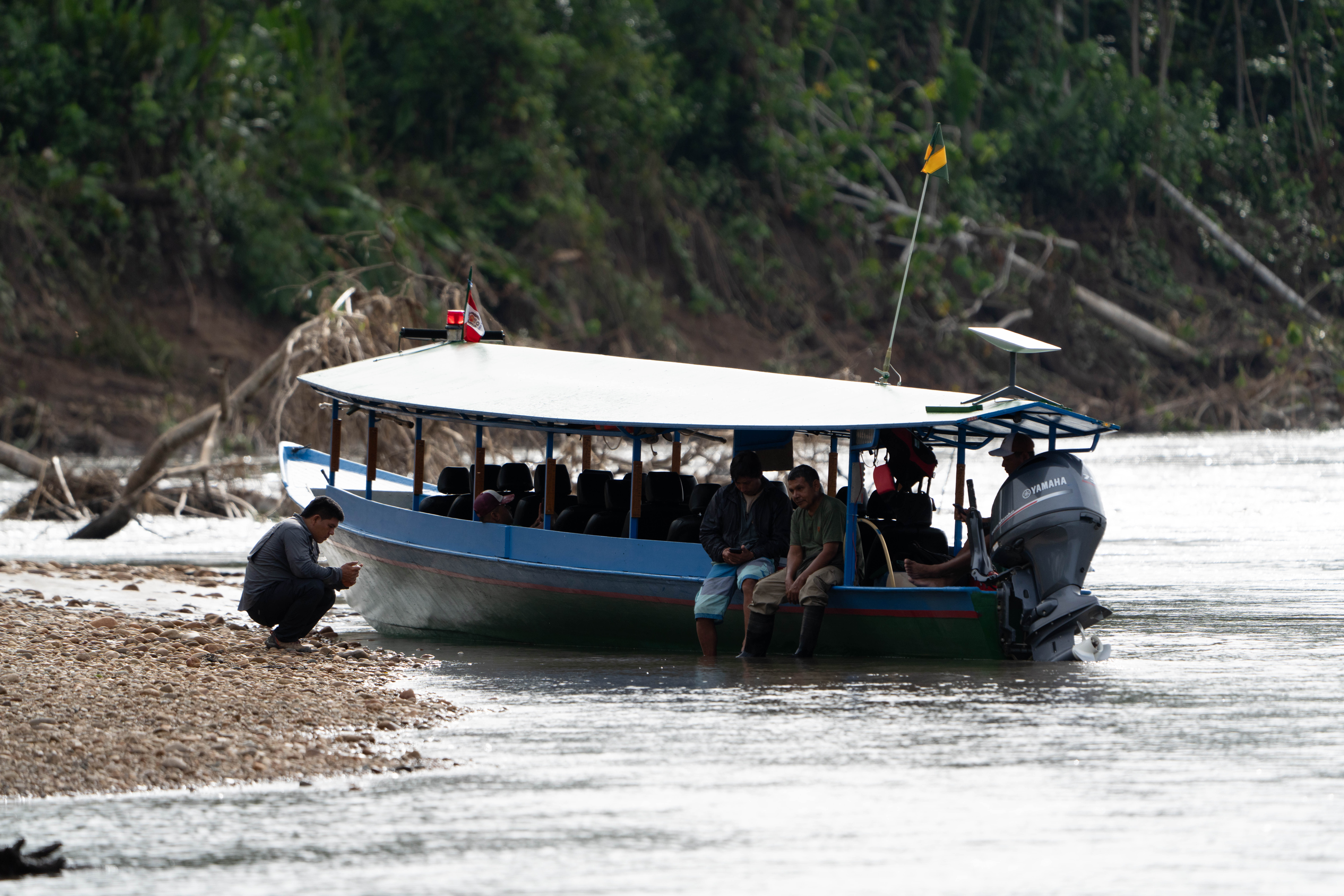
Like the changing river, so does our experience of travel. We oscillate between discomfort and pleasure, between serendipity and banality. We find joy in discovering new places and we lament the repetition of the airport rigmarole. We have our expectations exceeded and we find disappointment in unmet hopes. On this trip, we encountered both the best and worst aspects of travelling.
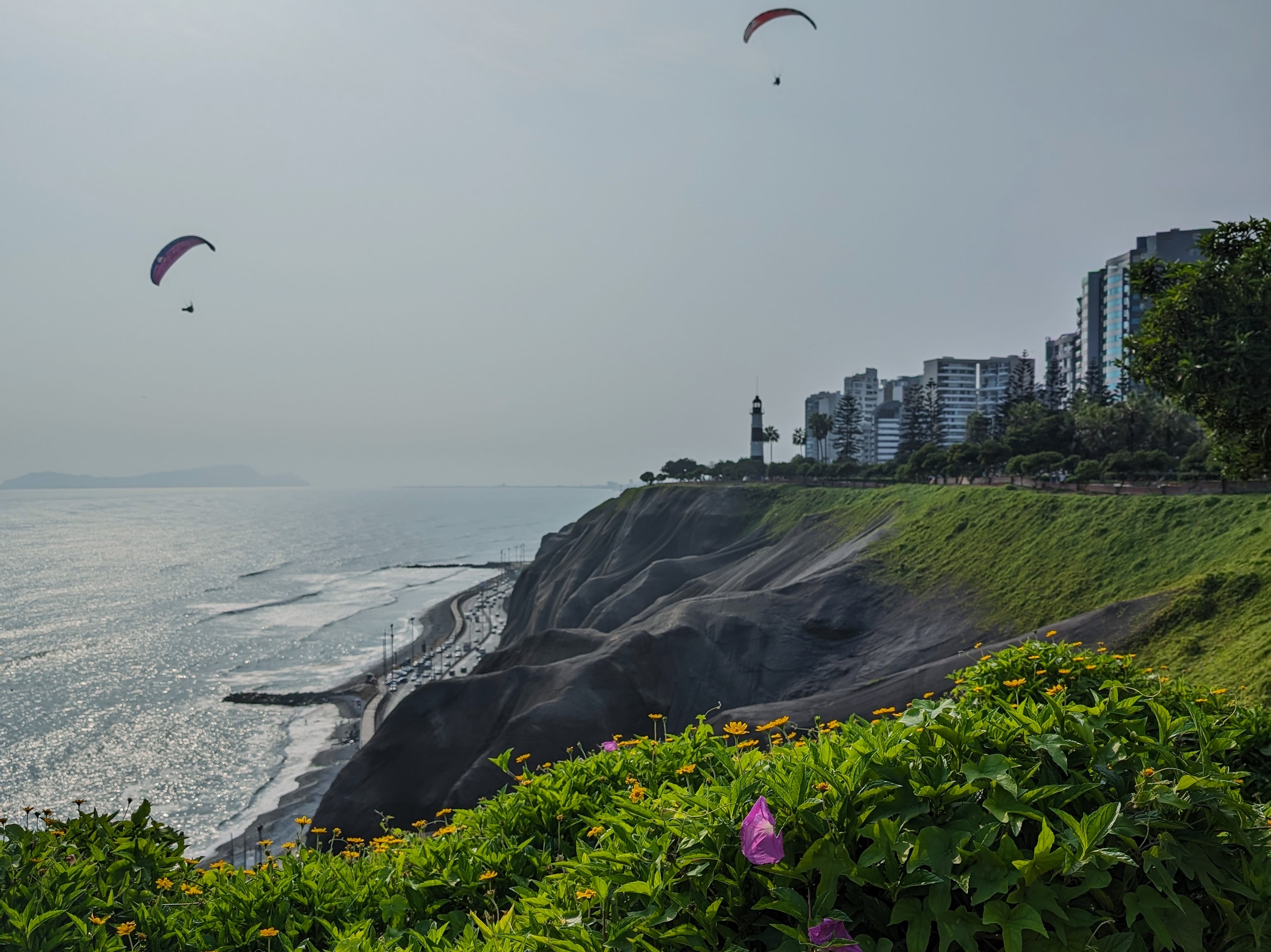
Lima city
The apartment we booked in Lima had no air-conditioning and no fans. And although there was some semblance of cool breeze in the evening, we were located above a noisy street where the music continued until 3am, and so leaving the windows open wasn’t an option. Lima was a constant 29°C with at least 80% humidity and the air was thick with pollution. After the first night, Max and I swiftly rectified the situation by going to a store to buy a couple of pedestal fans for the apartment. It took the edge off, but it was still many nights of restless sleep. Adding jetlag to that made for a pretty sleepless week.
Max and I flew to Lima via Santiago, meeting Dylan in Lima after his trip to the US. Flying into Santiago was spectacular as we crossed the southern Andes, their summer peaks still topped with ice. We spent a few hours waiting around at Santiago airport for our connecting flight to Lima, napping on the ground at the gate in the late afternoon, struggling to keep our bodies awake following a sleepless 13 hour flight and a circadian cycle still stuck in the early hours of pre-dawn.
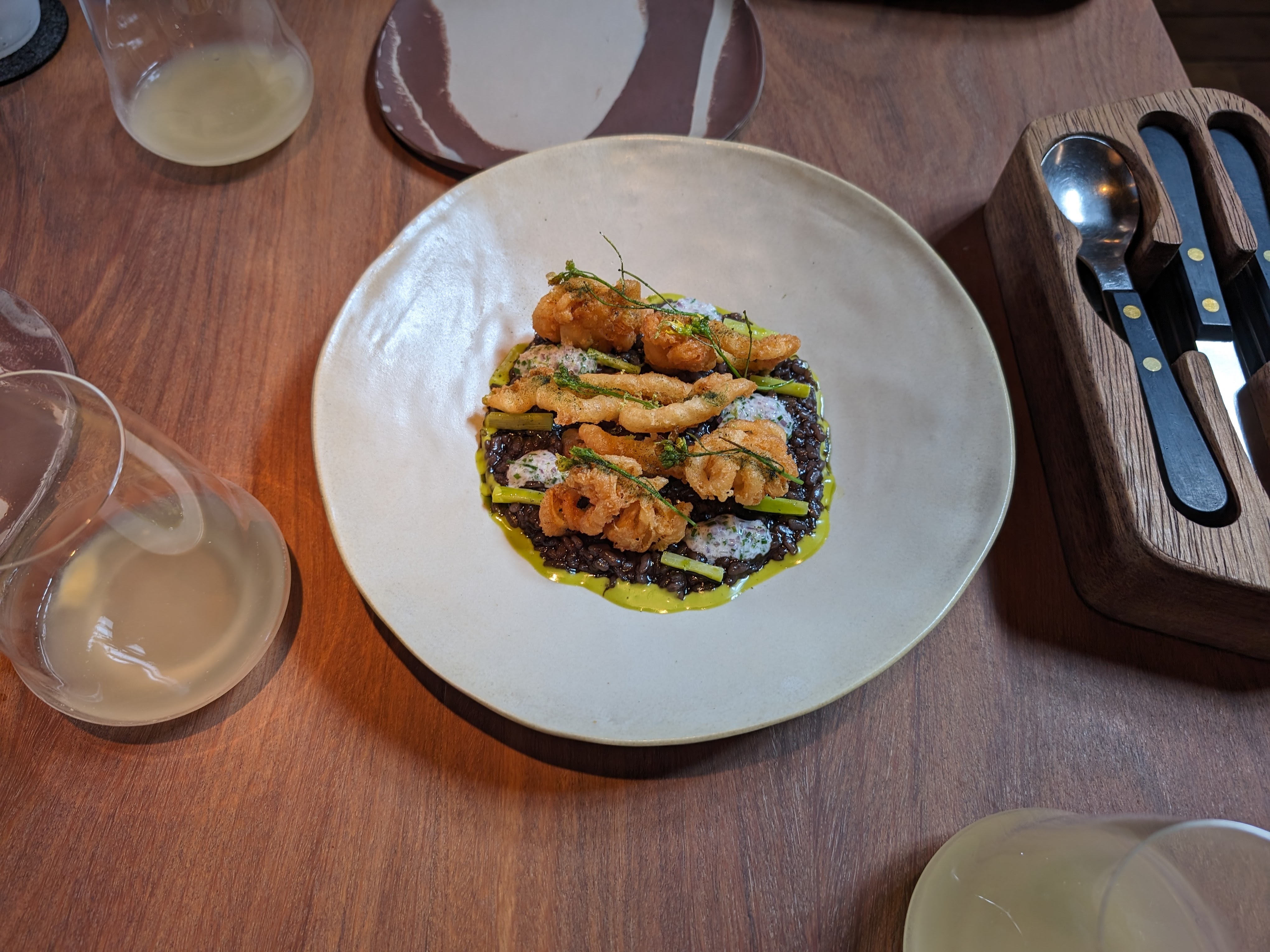
Food in Lima
We arrived in Lima in the evening and took the 45 minute ride to the up-scale district of Miraflores where we would be staying for the next week. Lima is renowned as the gastronomic capital of South America - a city of culinary delights using ingredients from the three distinct geographic regions of the country: the Pacific ocean, the Andean mountains and the Amazonian rainforest.
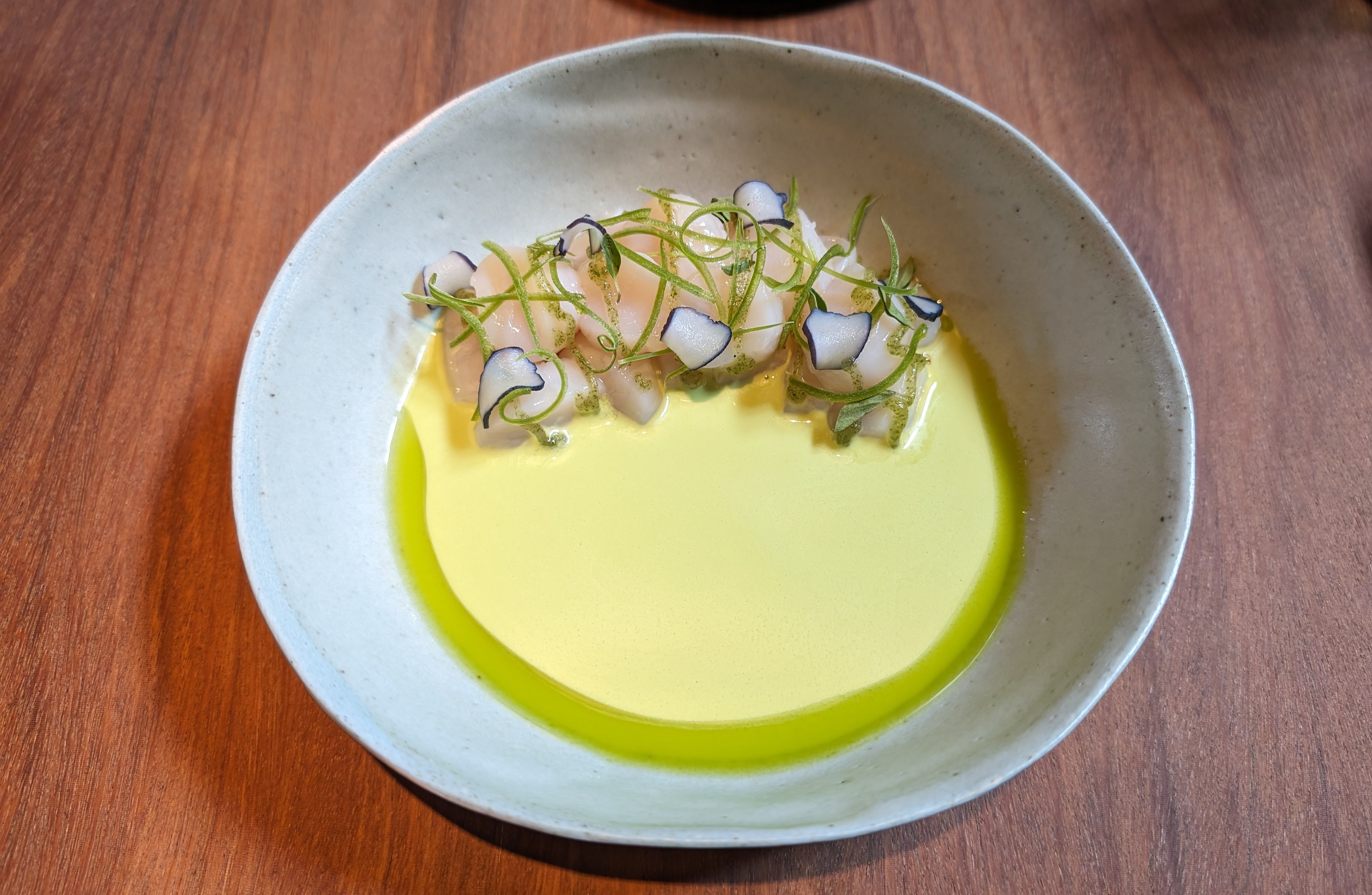
A ceviche dish at Mérito restaurant in the upmarket Barranco area
In fact, one of its restaurants - Central - was named the world’s best restaurant in 2023. We decided to skip the pleasure of forking out $600 each for dinner (with a high risk of being served some of Peru’s more interesting cuisines). Instead, we explored some of Lima’s other restaurants.
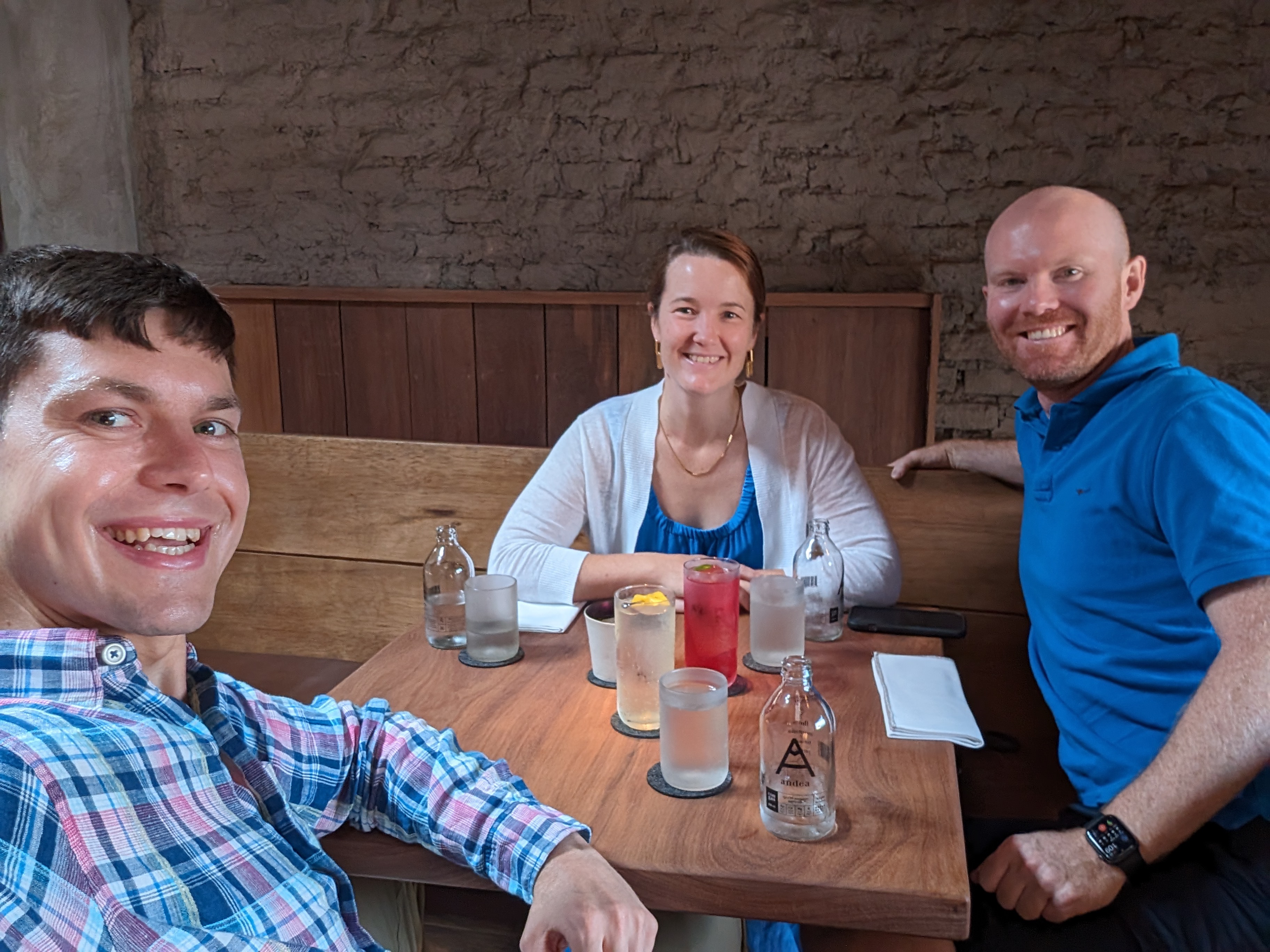
Us dining at Mérito restaurant
We had mixed success. We had an exceptional dining experience at Mérito, exquisite cocktails and bar food at the cocktail bar Lady Bee, and a wonderful long lunch at Matria restaurant. But the drinks at the renowned cocktail bar Carnaval were terrible and our plan for dinner and drinks at Bijou bar failed when they weren’t serving food. Their drinks were also hit and miss; with some classics being prepared to perfection and other drinks not quite hitting the mark. I had also really wanted to go to Kjolle but it was closed while we were there.
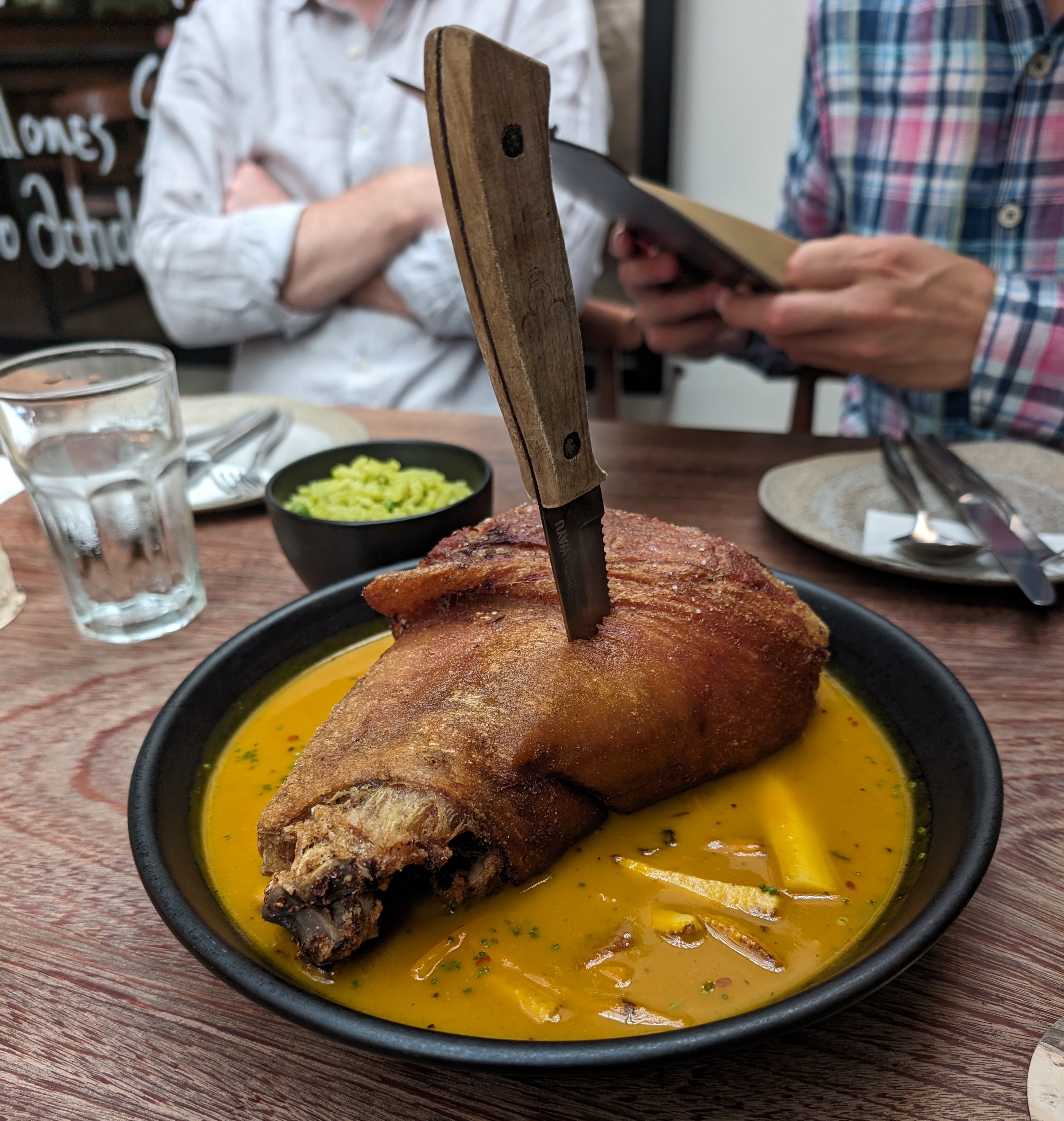
The pork knuckle at Matria restaurant
After our week in Lima, we went once more back to the airport to take a flight to Iquitos, the gateway to the Peruvian Amazon river and our departure point for a 4 night boat tour onboard the Delfin III. Iquitos is very remote, tucked away deep in the northern Peruvian Amazon jungle, and is reportedly the world’s largest continental city without a road connection.
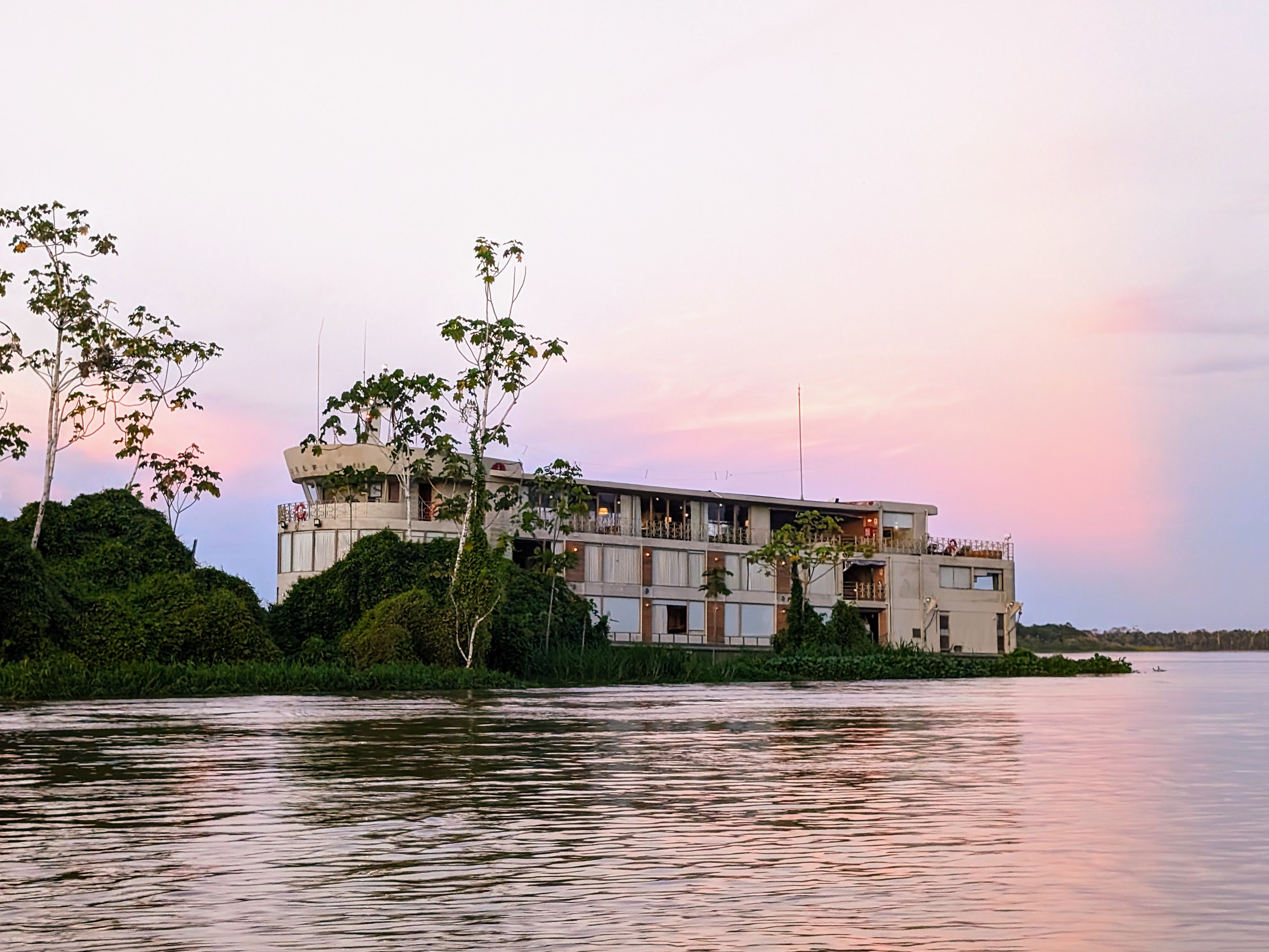
The Delfin III at sunset
We arrived at Iquitos airport, deep in the northern part of Peru, near the borders of Colombia and Brazil, stepping off the plane, onto the tarmac and into the steamy tropical air. We were greeted at the airport and drove a few hours to the river to join the boat. The source of the Amazon starts high in the Andes mountains and many tributaries flow to form the mighty river which is the largest in the world by discharge volume of water. There is some debate about whether it is also the longest river in the world, or whether that title is held by the Nile. In any case, we would spend five days navigating the Ucayali tributary and the Marañón River, the principal source of the Amazon River, arising about 160km to the northeast of Lima high in the Andean mountain range.
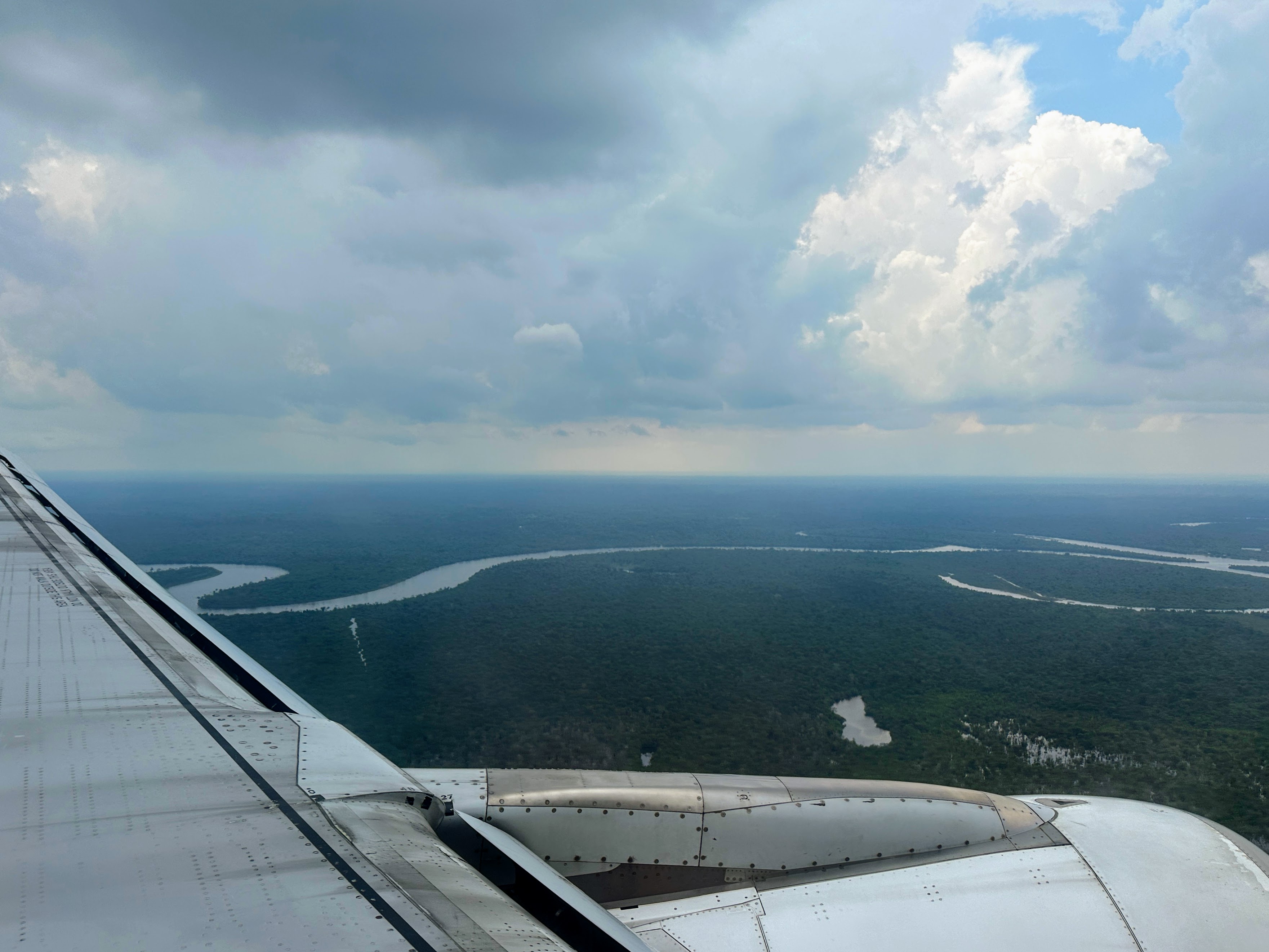
Flying above the Amazon River into Iquitos
We were there towards the end of the wet season. It should have been raining every day, but we were lucky to have only one day of rain during our five day tour. The conditions were perfect for navigating the river. It wasn’t raining but the water level was still high from the rains. This annual phenomenon creates the most extensive flooded forest system on Earth, as the heavy rains cause the water level to overflow from the rivers and flood the forest, blurring the boundary of where the forest ends and the river begins.
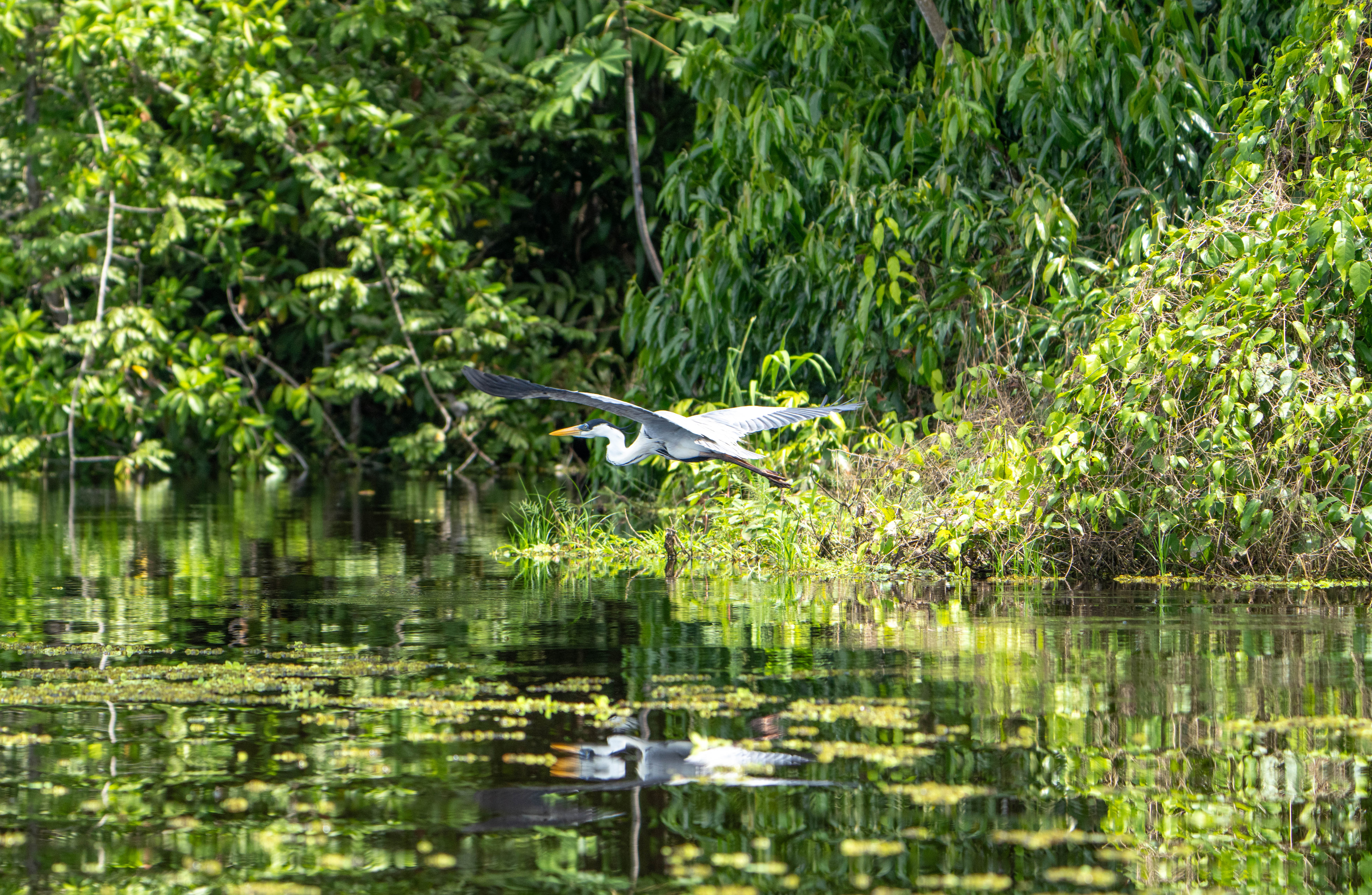
This enabled us to navigate deeper areas of the forest back from the official river’s edge. Each day we had a number of opportunities to go out on the skiffs with our expert guides to spot some wildlife.

Navigating the river on the skiff
The guides had an exceptional eye, able to spot the smallest smudge in a faraway tree that they identified with an uncanny level of precision from the vaguest silhouette.
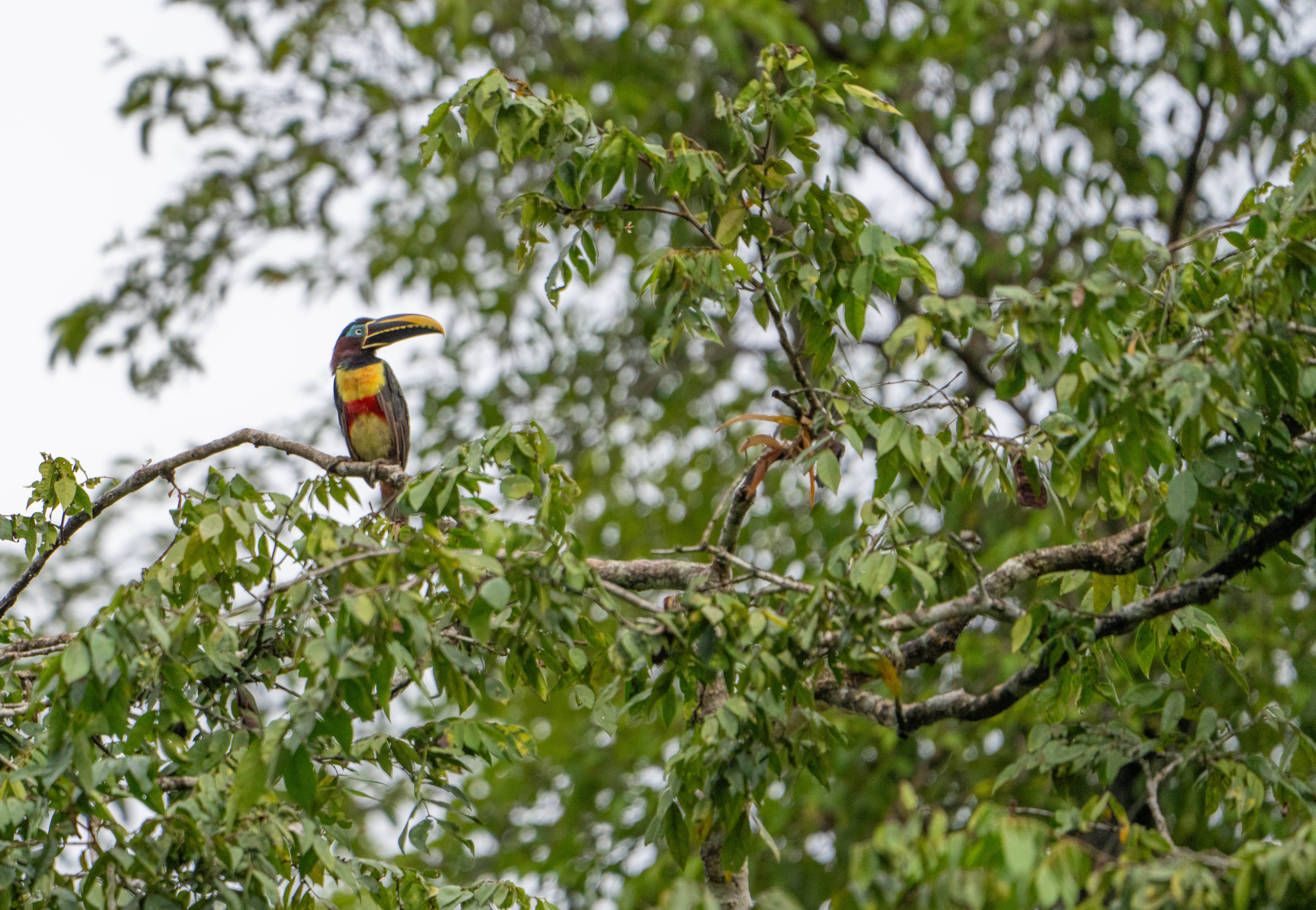
A chestnut-eared aracari toucan
They’d drive the skiff closer and we’d have the chance to witness wildlife in its purest form. We would discover monkeys playing in the trees, sloths chilling out upside down, turtles sunning on logs, and toucans perched on a branch.
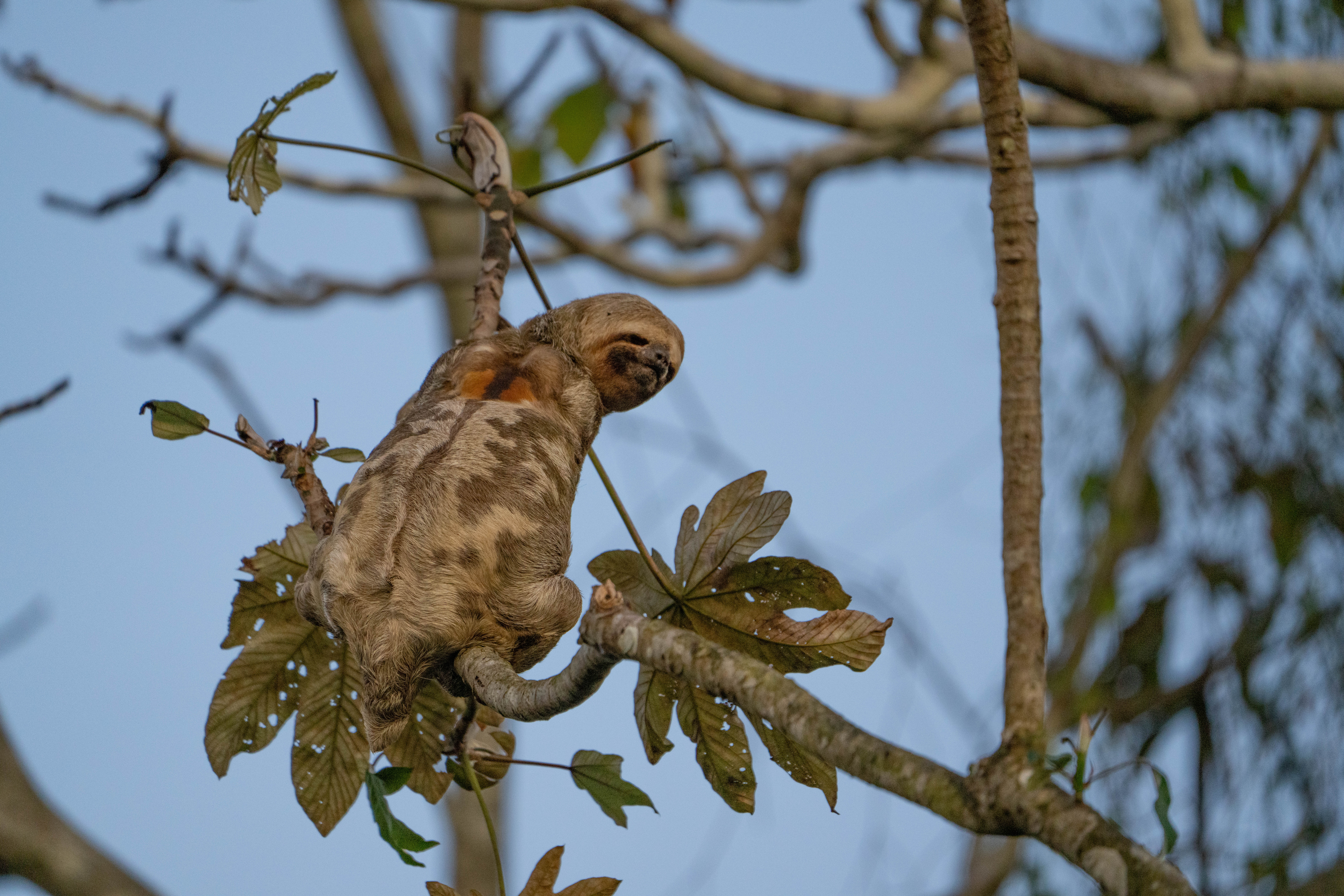
A three-toed sloth
The variety of birds we saw was amazing, and we loved finding macaws, my favourite rainforest bird.
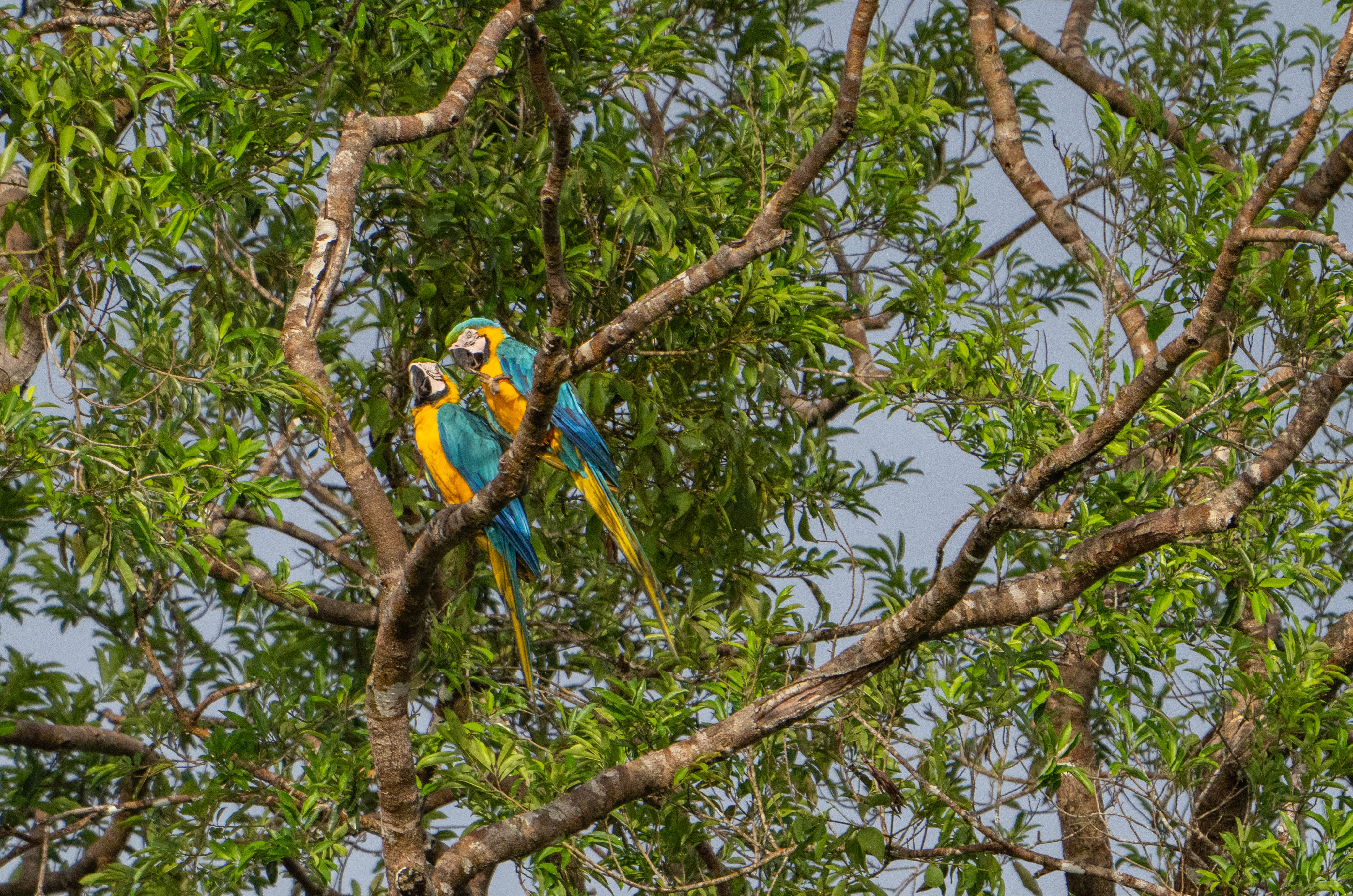
Yellow and blue macaws
But I think the most joyful experience was finding a troop of monkeys. We would sit quietly in our boat below the trees and spend time watching them jump from tree to tree and climb across the branches.
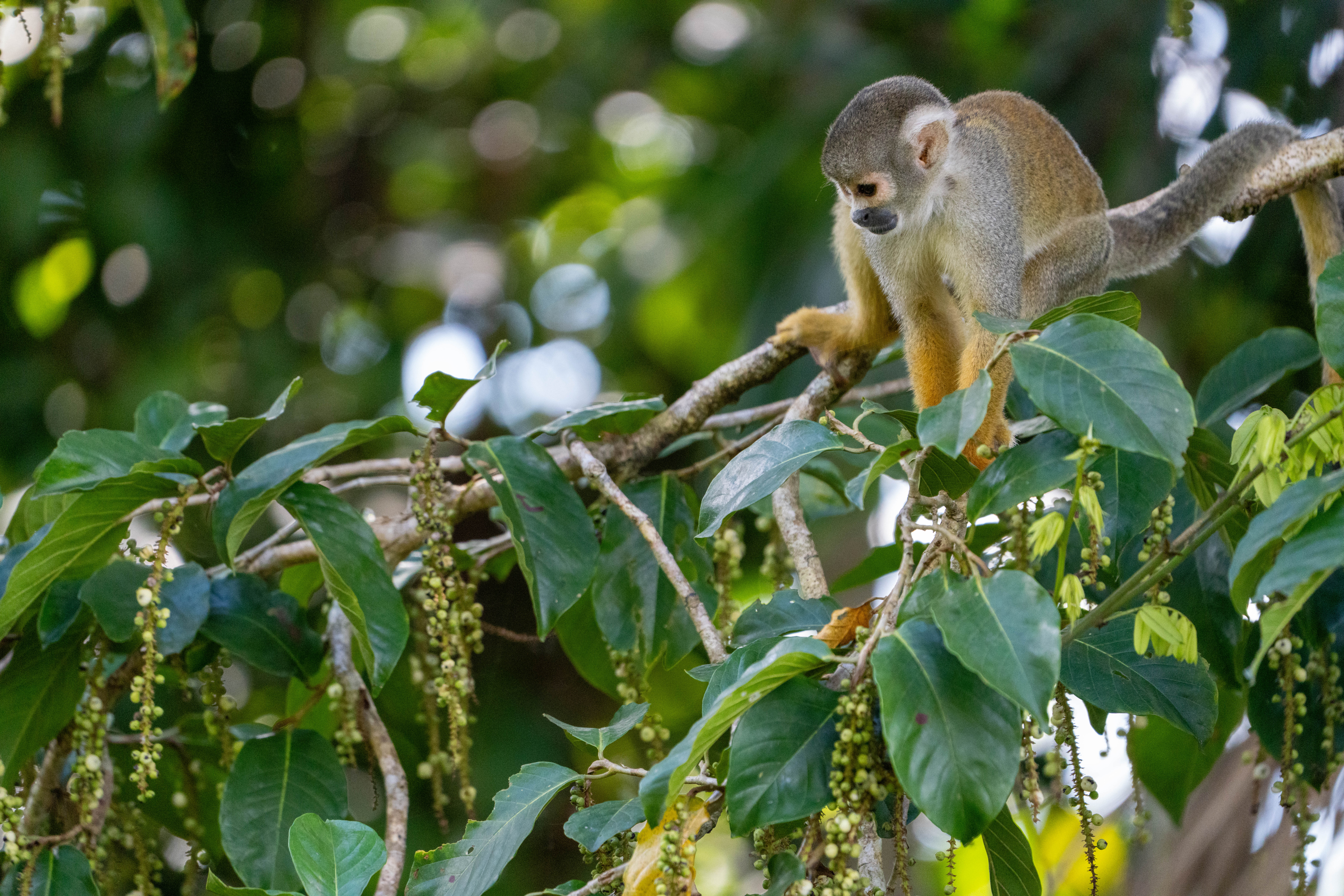
A squirrel monkey
We saw squirrel monkeys, capuchin monkeys, black titi monkeys and howler monkeys, which are the loudest land mammal on Earth; their vocalisations able to travel up to 5km through the dense forest.
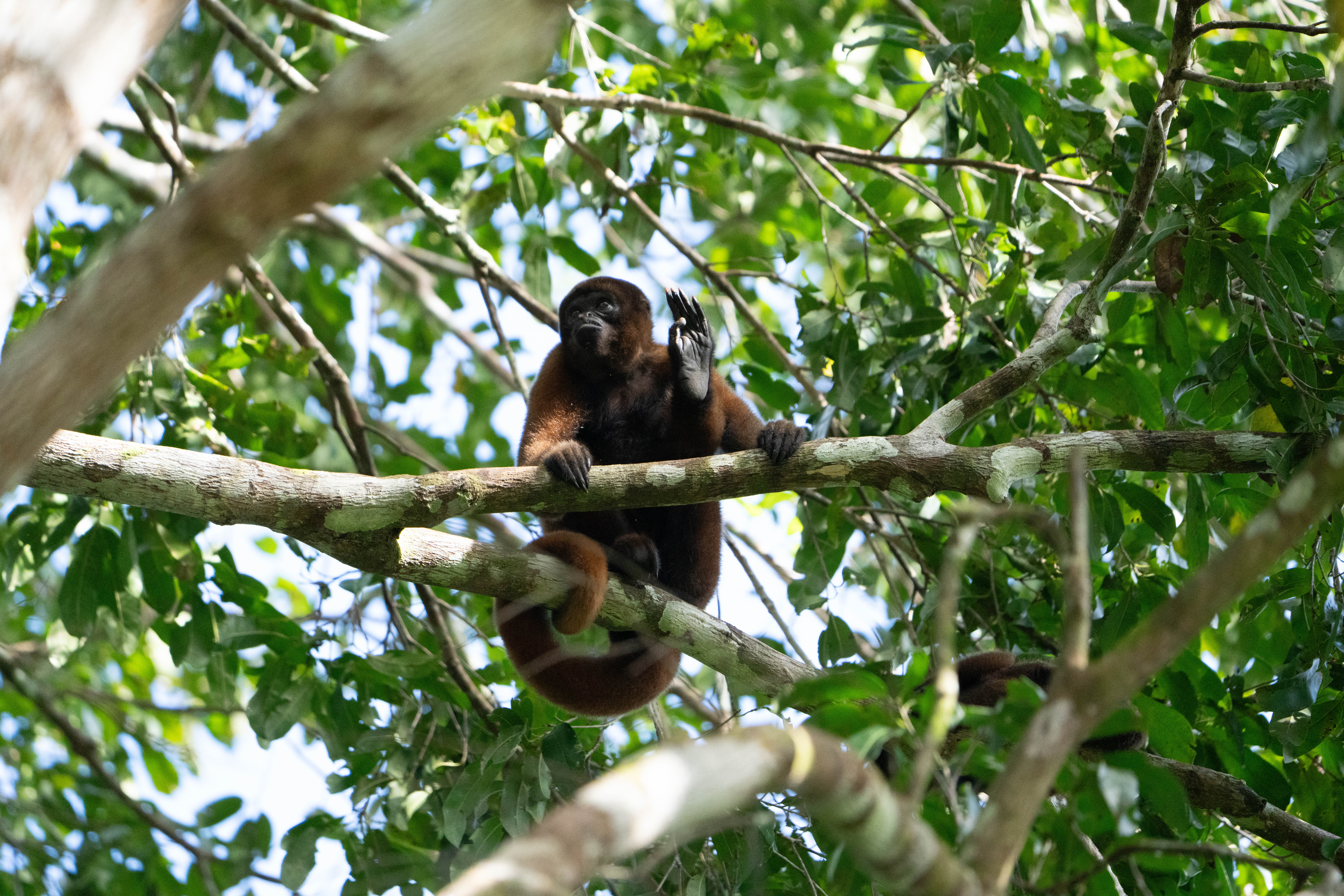
A red howler monkey
One day we took the skiffs to the centre of a blackwater tributary of the river. The dark colour results from the leaching of tannins from the decaying leaves of adjoining vegetation. The blackwater has a different chemical composition to other parts of the Amazon river, keeping parasites and bacteria to a minimum and making it nutrient deficient. There is also not a strong current, like the main river. This all means that it is safe for swimming. We spent an hour or so cooling off in the water as we bobbed around on the noodles they provided us. Swimming around us were the iconic Amazon pink dolphins.
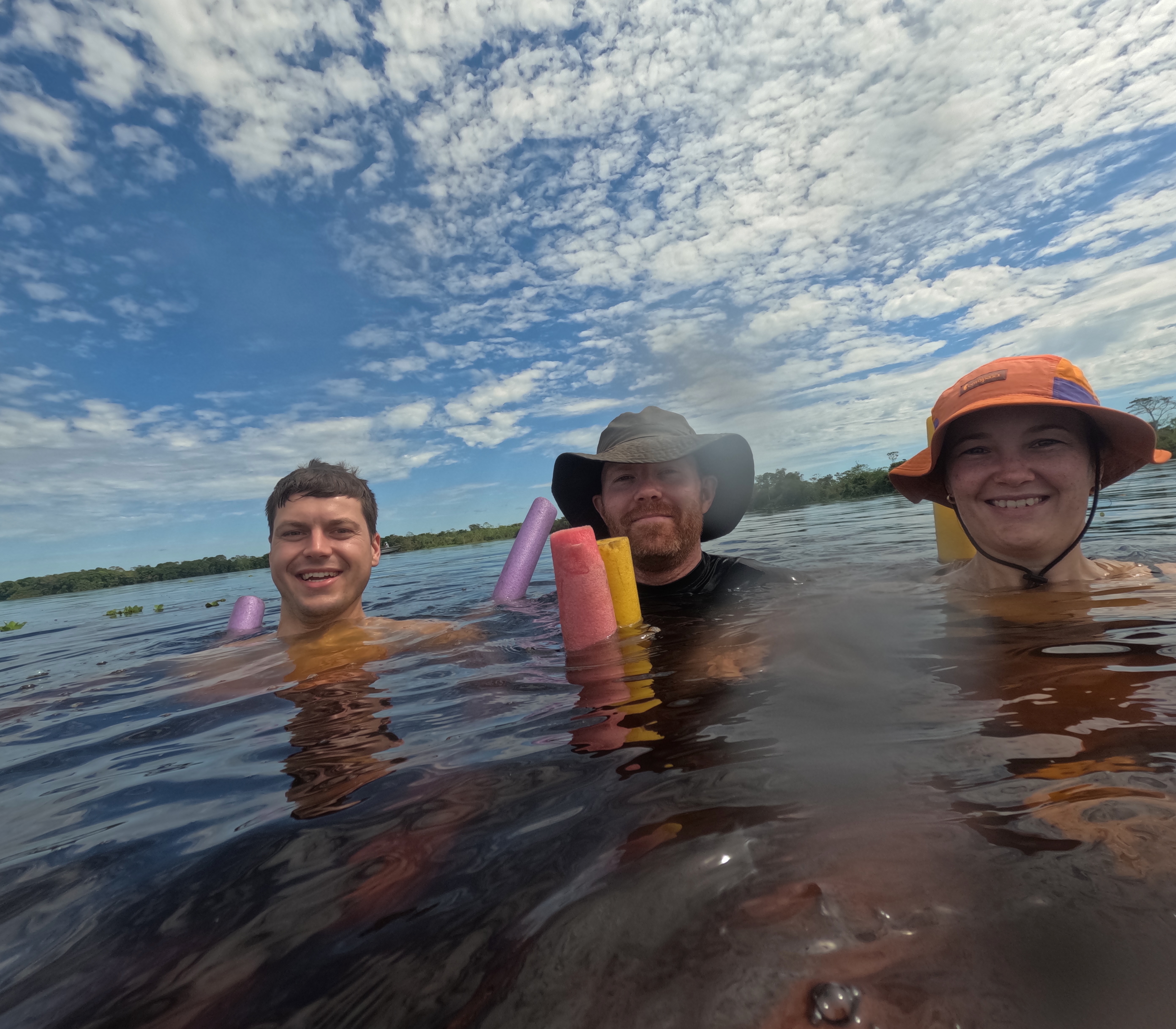
Swimming in the Amazon
After a morning or afternoon activity, we had free time to nap in our air-conditioned rooms or sit in the lounge area and enjoy a pisco sour. We also used the down time to sort through the hundreds of photos we had after each excursion, trying to stay on top of the increasing volume of photos so that we wouldn’t be overwhelmed with thousands of photos at the end of the trip.
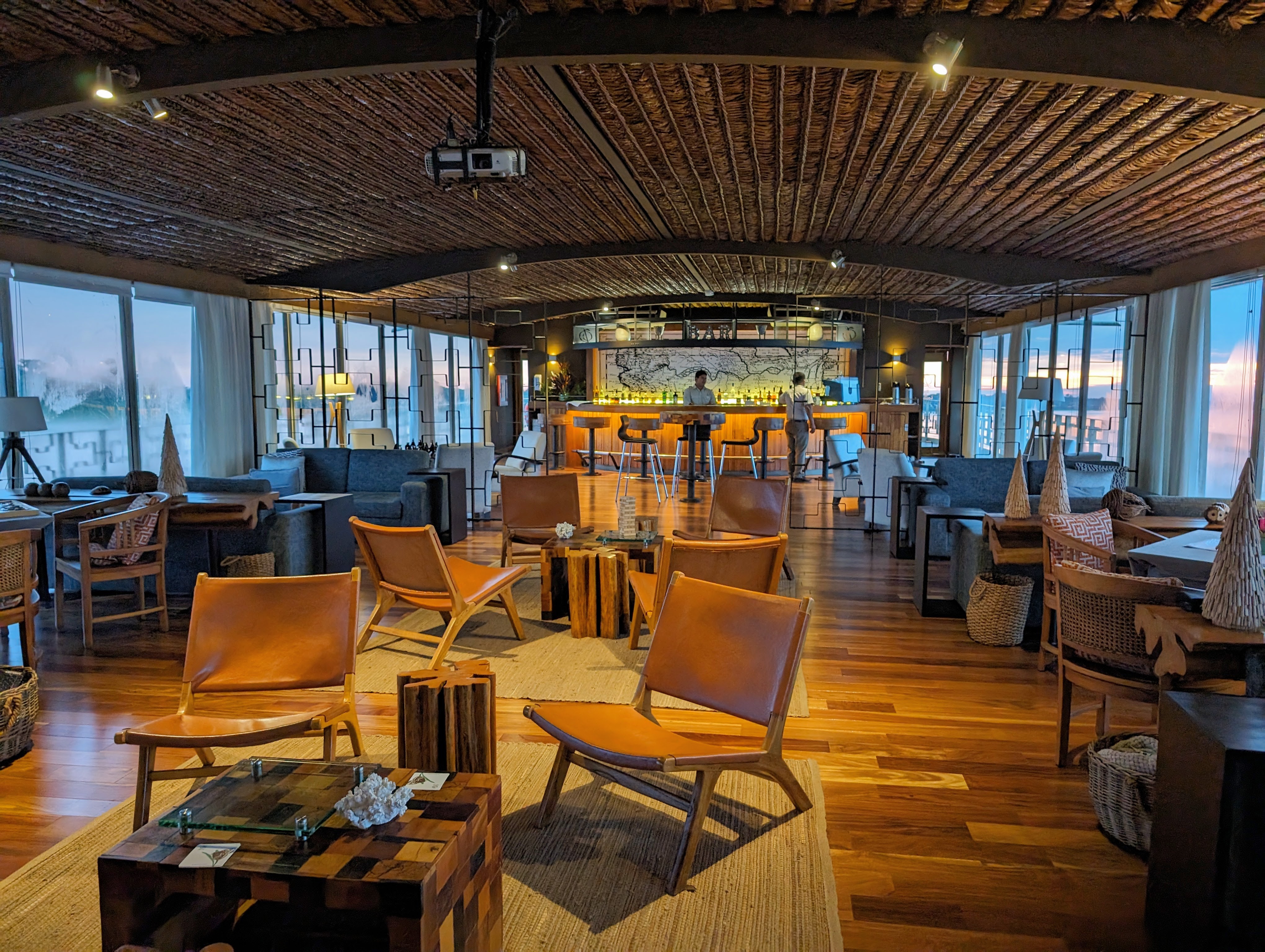
The lounge on the third deck of the Delfin
We were served ice-cold juices when we arrived back from an activity, and our rooms were serviced three times per day, including the placement of a different towel design on the bed each day. It was a luxurious and very professionally curated experience.
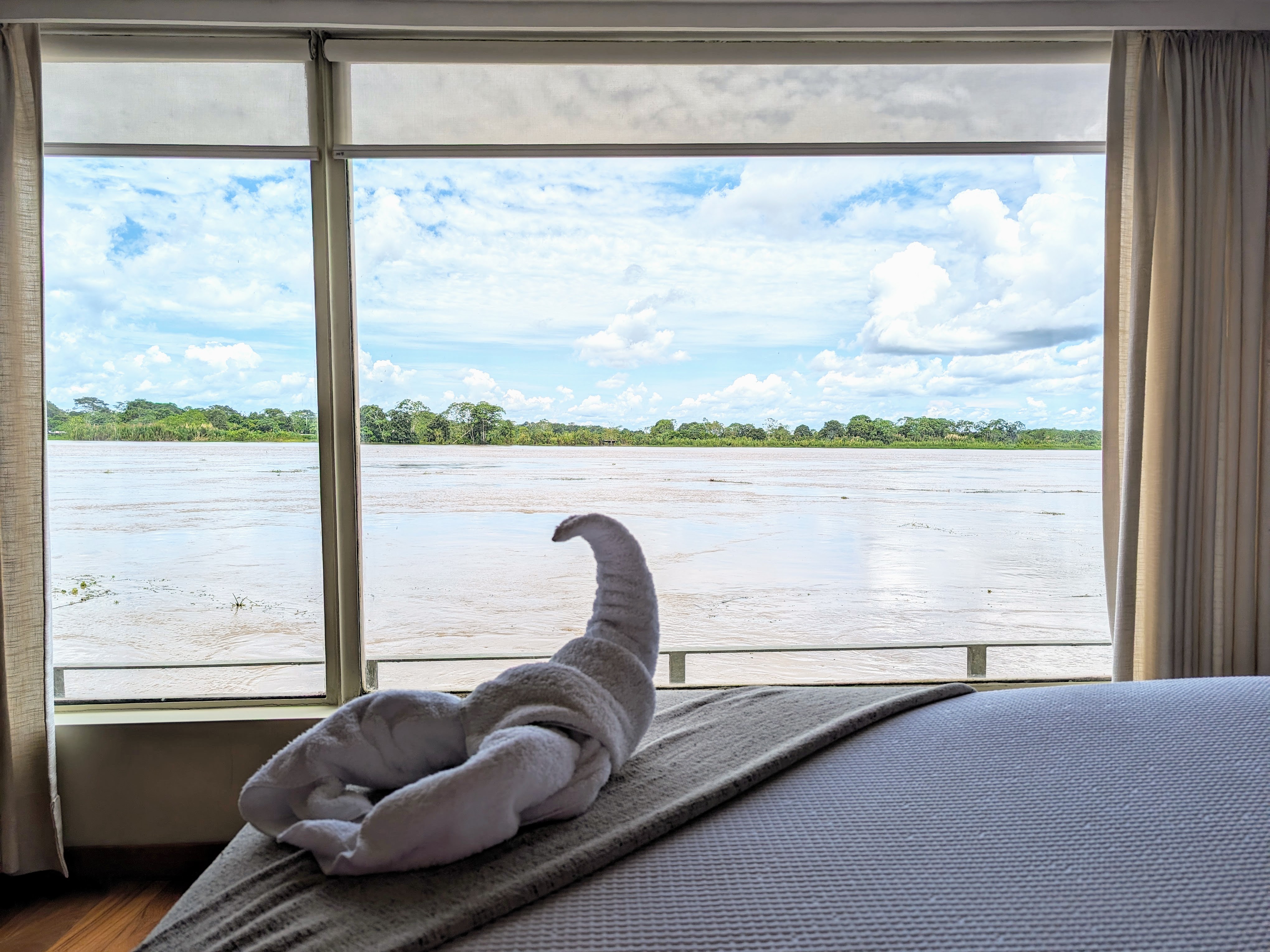
The view from our room on the Delfin with a lobster towel
All of the lunches and dinners were three course meals of exceptional quality. The ingredients were sourced locally and we ate delicious food prepared by skilled chefs. Each plate was presented beautifully and accompanied with a glass of wine and freshy made bread shaped into cute Amazonian animals like turtles and dolphins. We sat with different guests and shared travel stories, generating inspiration for future adventures.
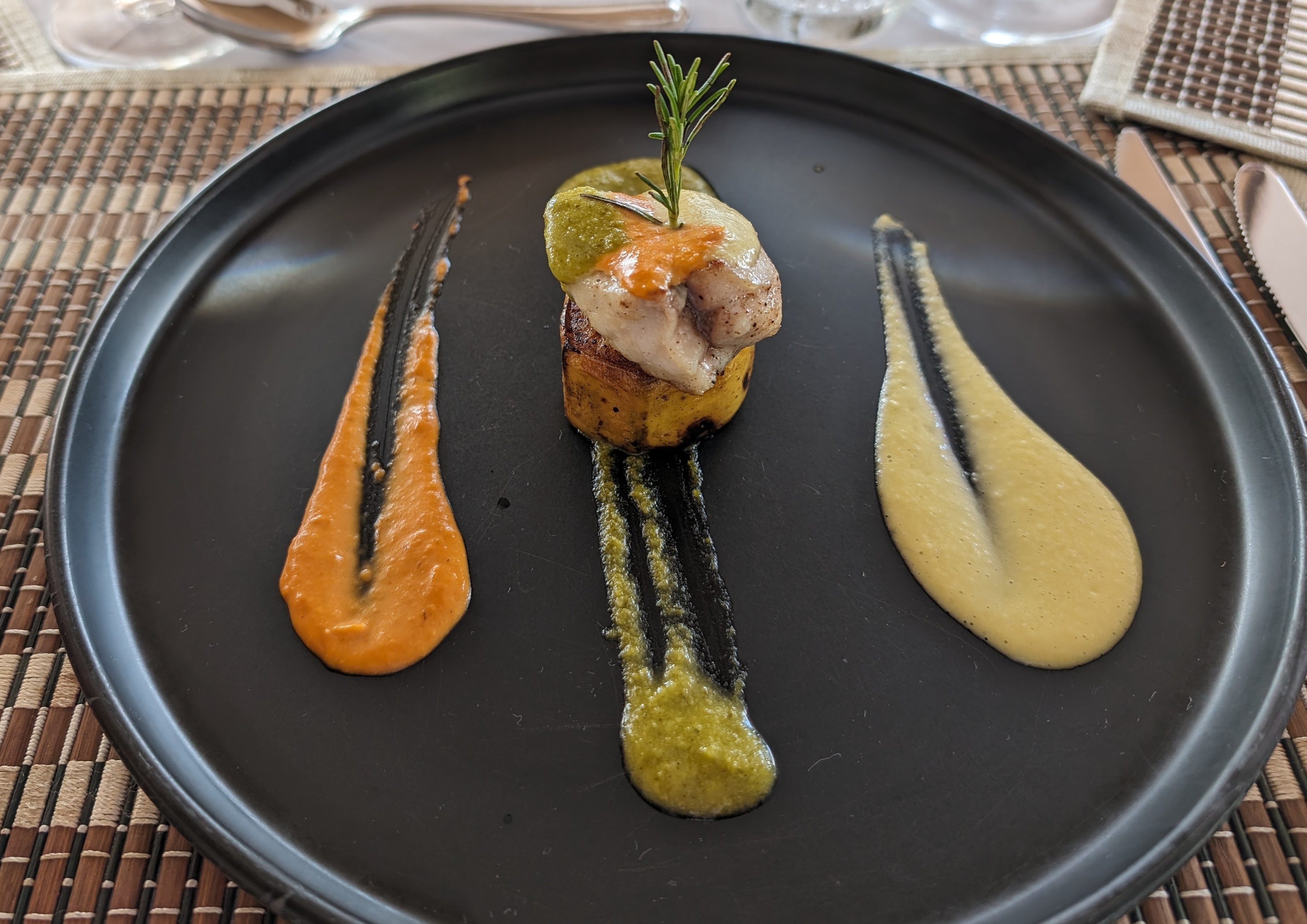
One of the beautifully presented starters we enjoyed for dinner on the Delfin
On our last full day of activities we visited a local village and went for a walk in the rainforest terra firma - those parts of the forest that remain unflooded dry ground during the wet season. Dylan held a tarantula and Max took the photo because I wasn’t anywhere nearby.

Dylan holding a tarantula
On our last night, some of the crew with hidden musical talents treated us to some songs and we enjoyed an amazing farewell dinner.
It was then another early morning start to commence our journey back to Iquitos for the second part of our Amazonian adventure.
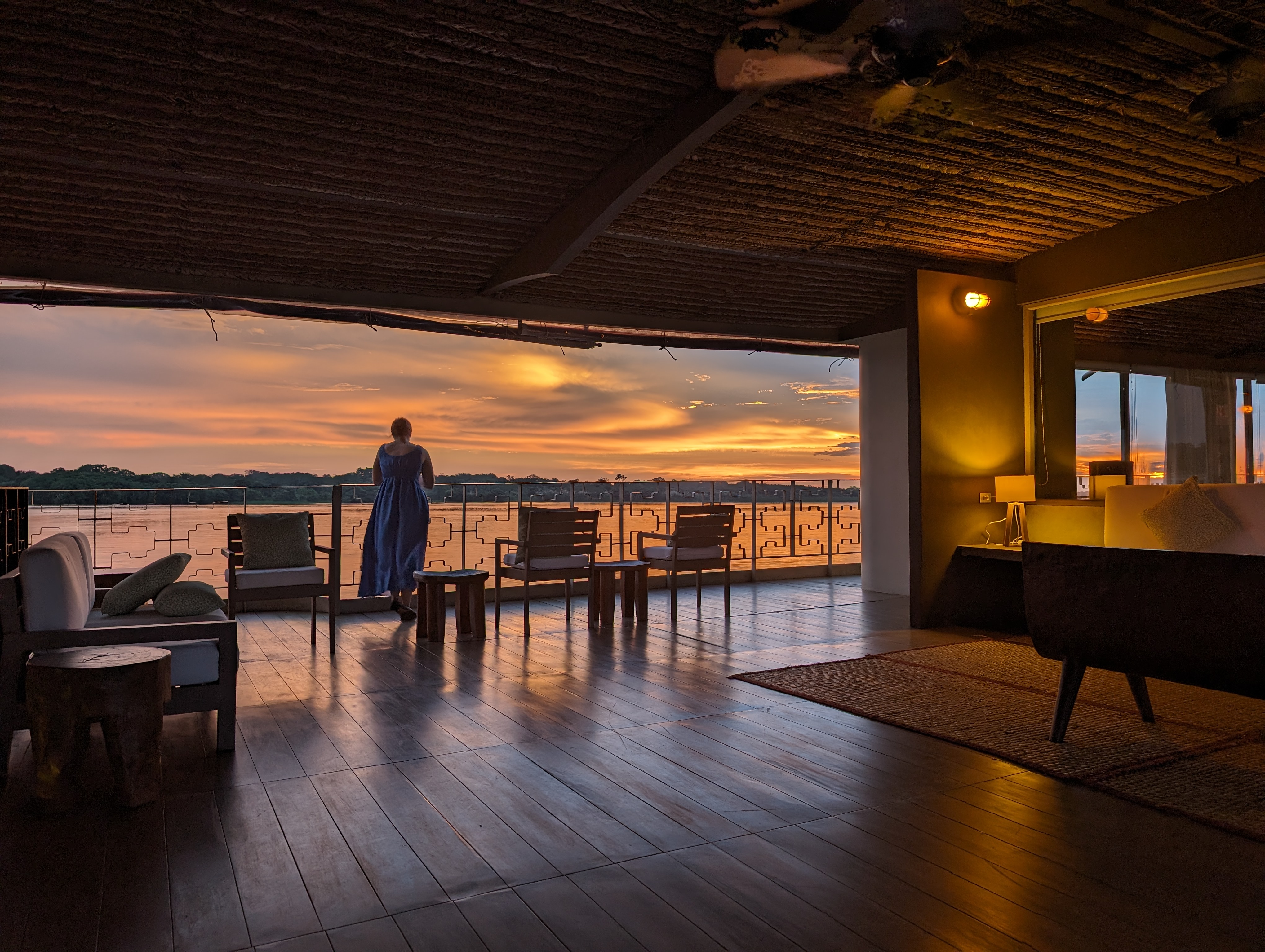
Sunset from the Delfin
Our next experience was in the southern part of the Peruvian Amazon at the Tambopata Research Centre. The TRC is located within the Tambopata National Reserve along the Tambopata river in the Peruvian region of madre de dios (mother of god) and is considered one of the most remote lodges in South America.
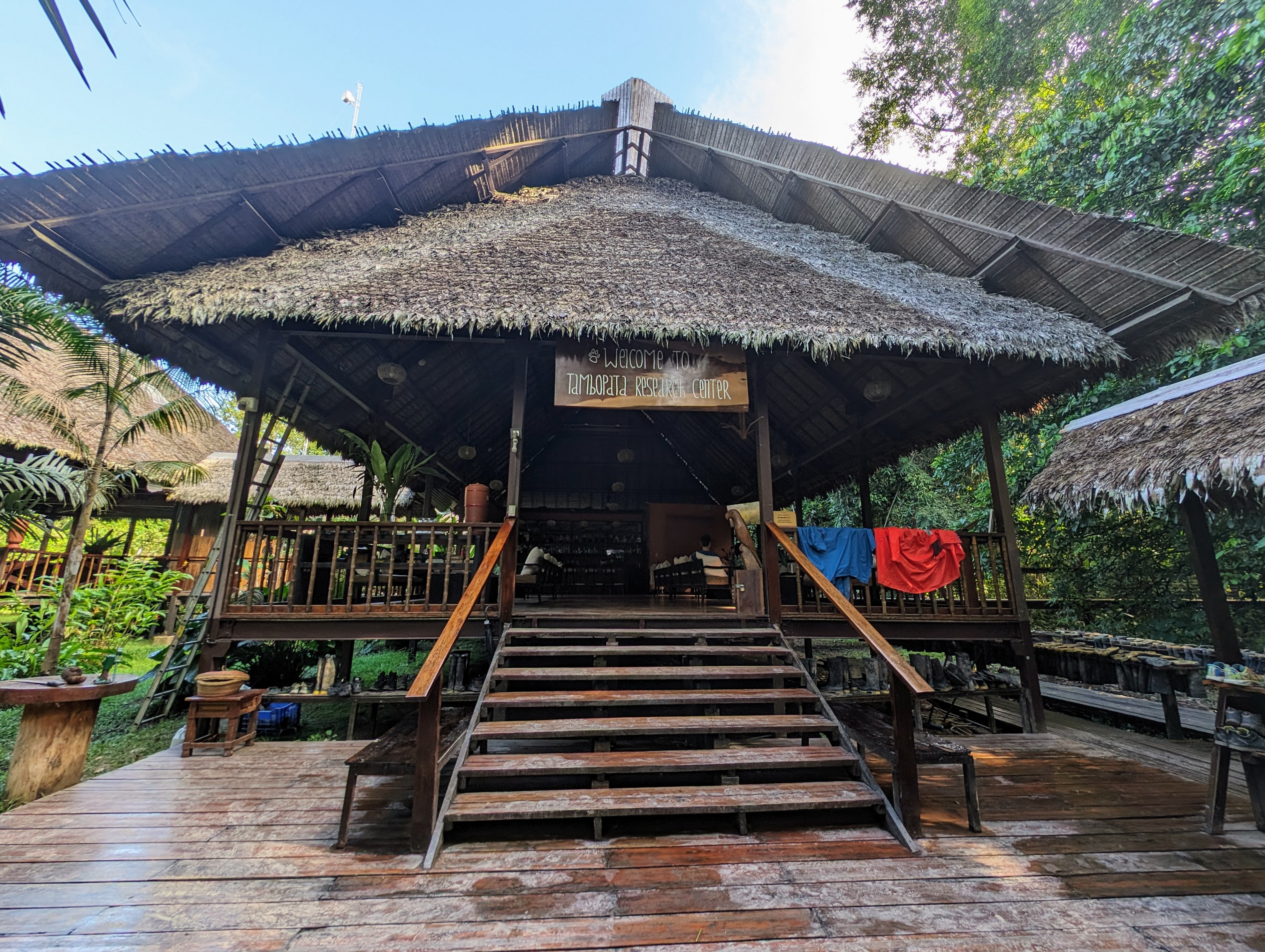
The Tambopata Research Centre
To get there, we took a flight back to Lima from Iquitos. We spent barely 8 hours in the Lima airport hotel, and after a 4am start, took another flight to Puerto Monaldo: a small city in southeast Peru known as a gateway to the southern Amazon jungle. From there, we took a short bus ride to the TRC office where we repacked our gear into duffle bags so we could leave behind our roller suitcases and any belongings that weren’t essential for our 4 night jungle experience because everything needed to be carried in by hand. After the bag shuffle, we once more boarded the bus and drove for nearly 2 hours by mostly dirt road to the Tambopata river where we then took a 3 hour boat ride upstream to reach the research centre.
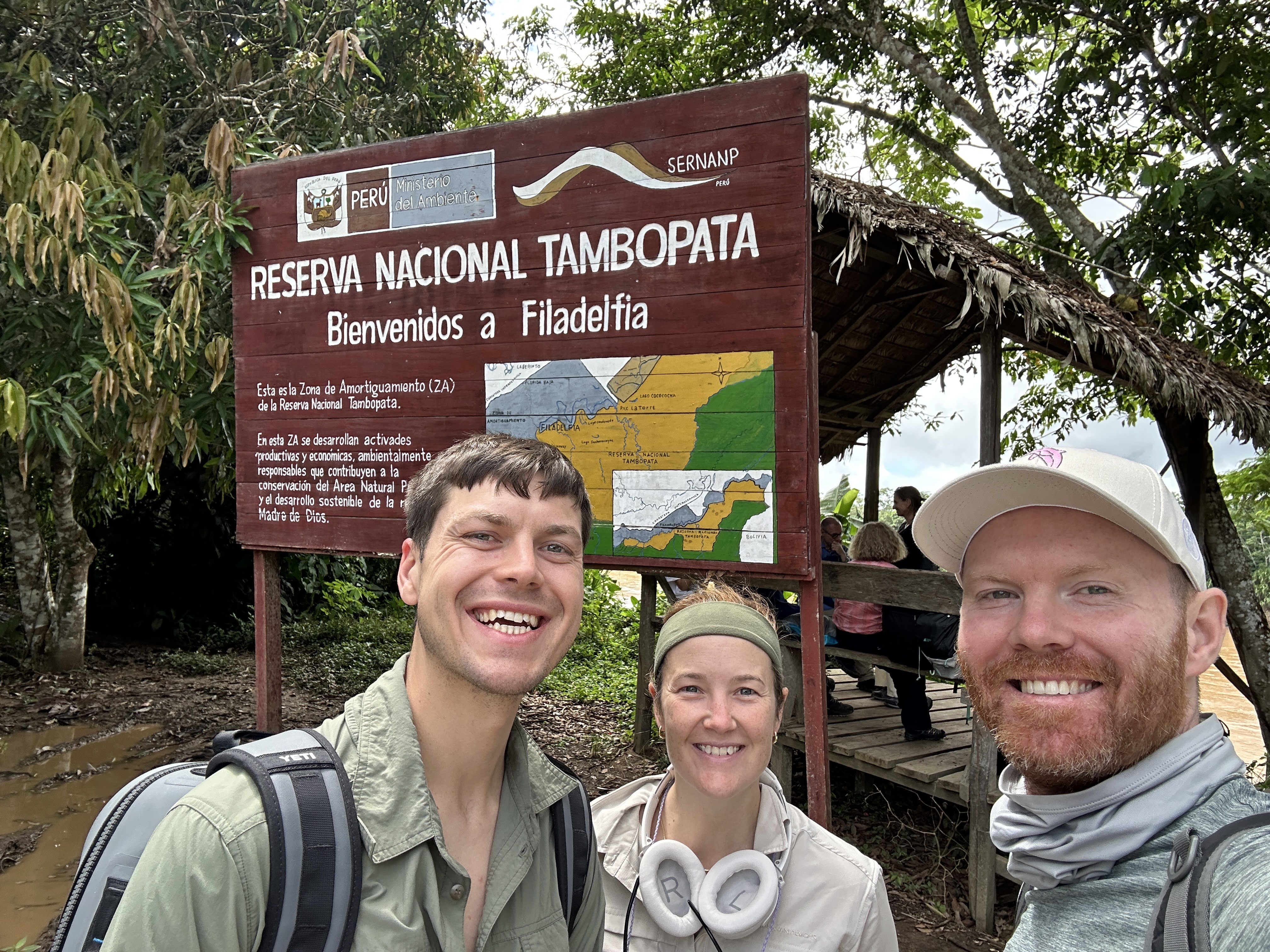
The point of embarcation for our 3 hour boat ride up the Tambopata River to reach TRC
Along the way, we saw our first capybara, the world’s largest rodent. The journey was slow, as the boat navigated the shallow parts of the river and the constantly changing curve of the meandering stream.
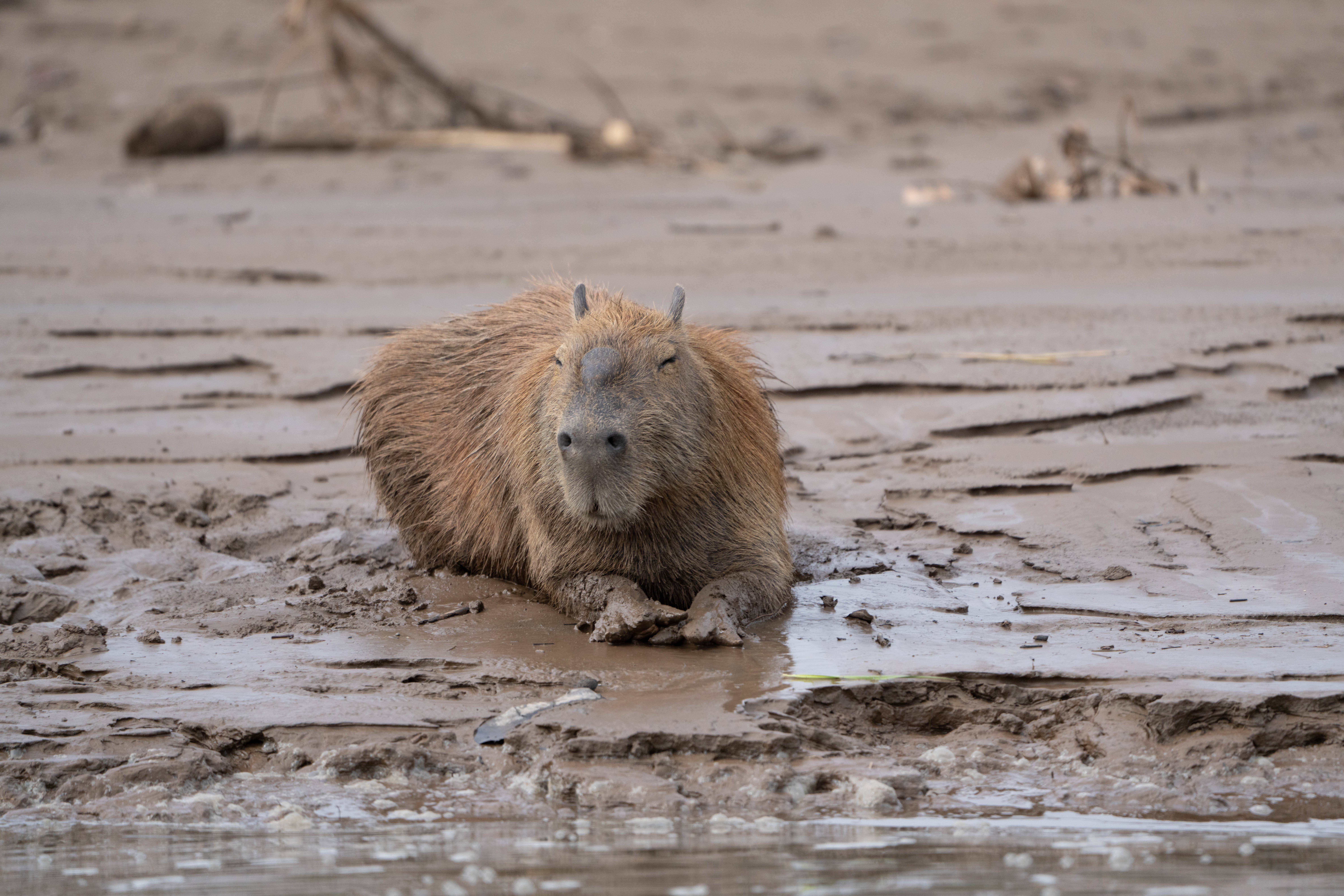
A capybara camouflaged in the mud
The multiple modes of transport and time required to get to the TRC is reminiscent of a bygone era of travel when the most remote places were not easy to get to and required a level of discomfort and uncertainty.
However, since it is a research centre where there are always resident researchers undertaking various studies, we had the luxury of WiFi. We had hot water for showers, although we never used it (except to wash our underwear), preferring a cold dowsing of water to rinse the sticky jungle off of us. The other surprise was good cocktails. They seemed to have managed to get a bartender with a genuine interest in good cocktails, so getting a jungle bird made to spec à la Smuggler’s Cove was quite a treat.
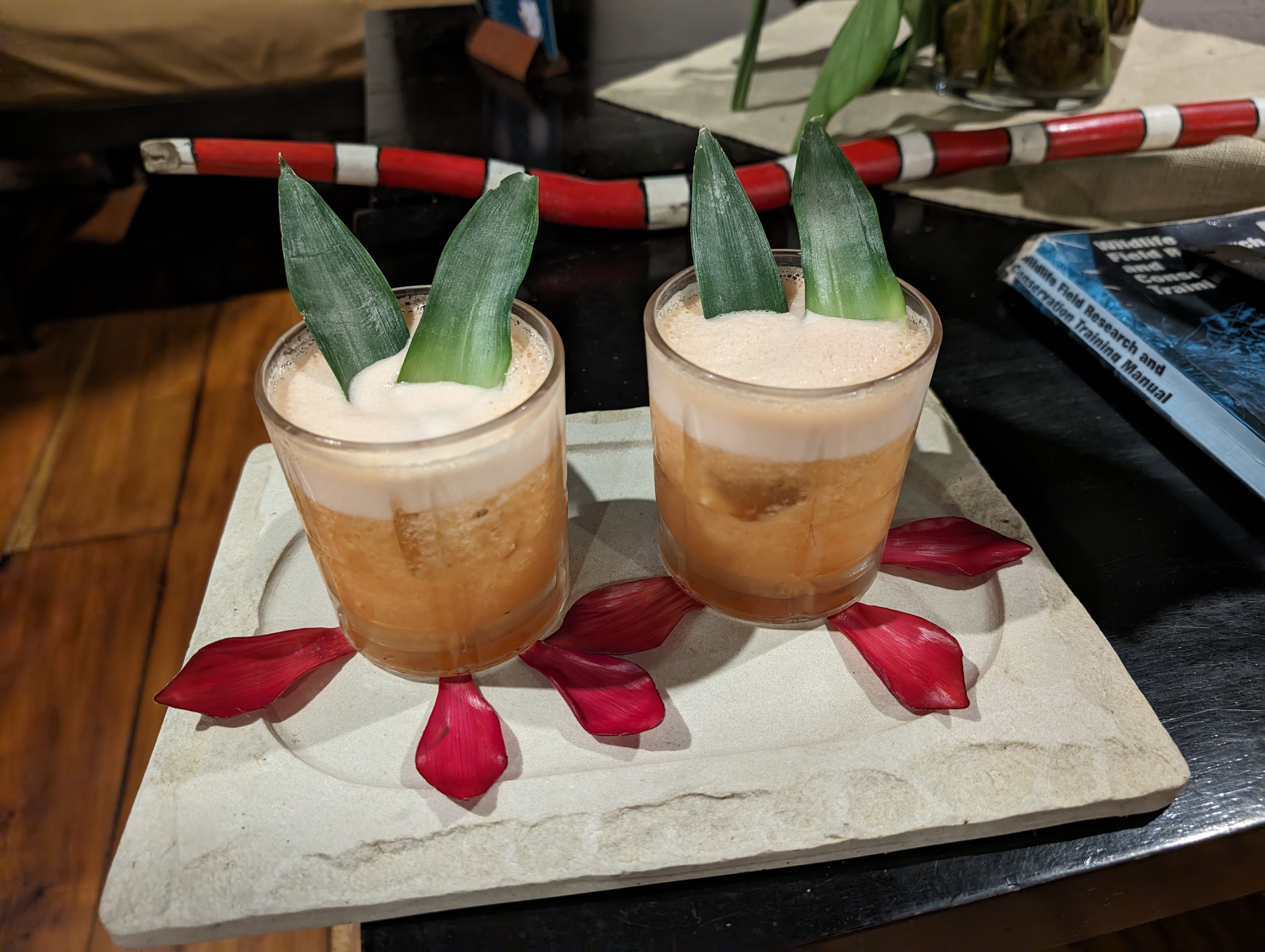
Jungle bird cocktails
The food was simple but decent; a buffet of salads, vegetables, rice and stews of chicken or pork. The beds were comfortable and covered with full mosquito nets to keep all manner of insects off you during the night. But other than that, the luxuries were limited.
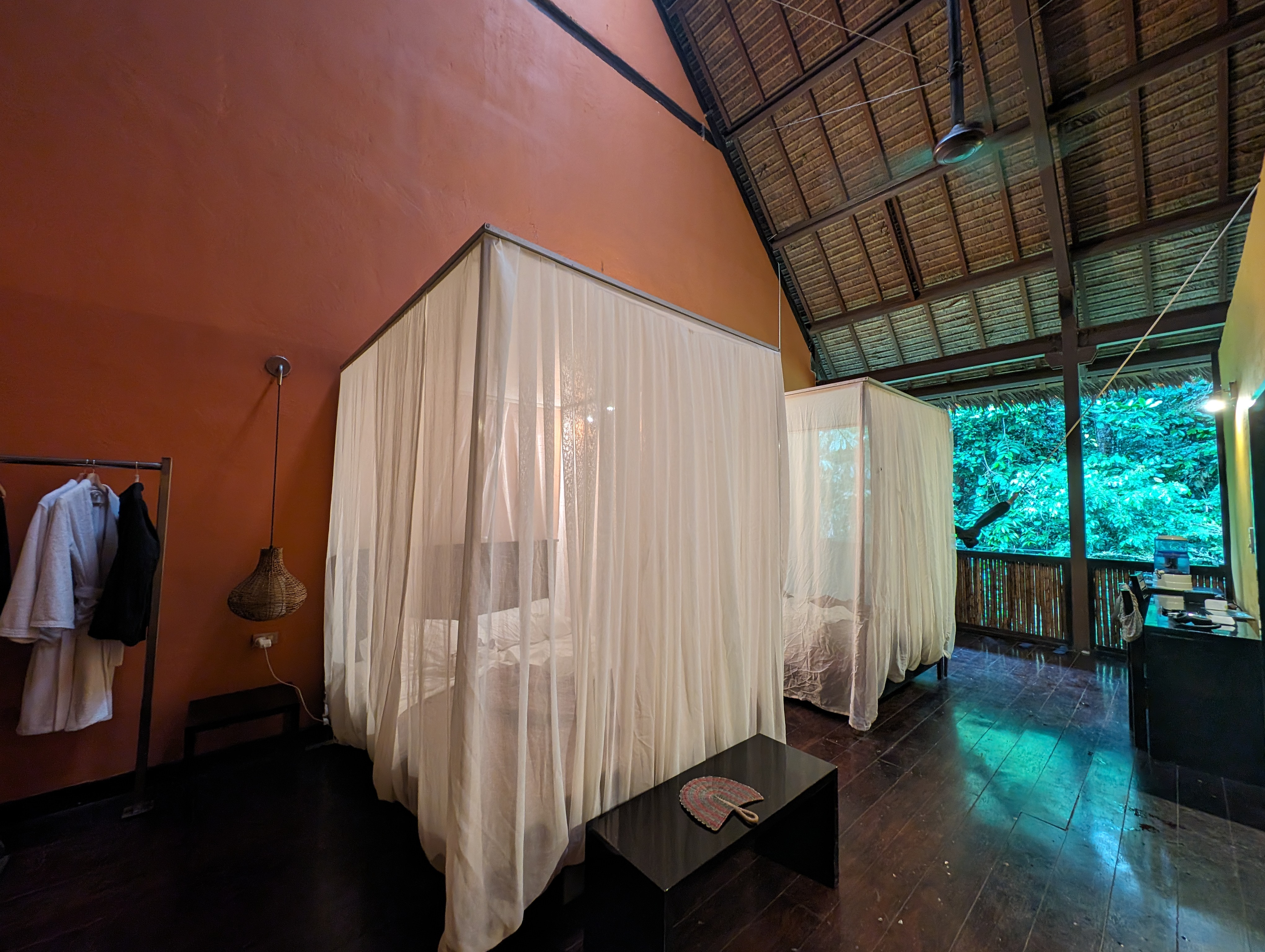
Our room with netted beds
But the remote and pristine location makes the wildlife experience here one of the best the Peruvian Amazon has to offer. This part of the Amazon is considered one of the most biodiverse places on the planet and Peru has the most species of birds of any country in the world, recently overtaking Colombia with the discovery of a new species.
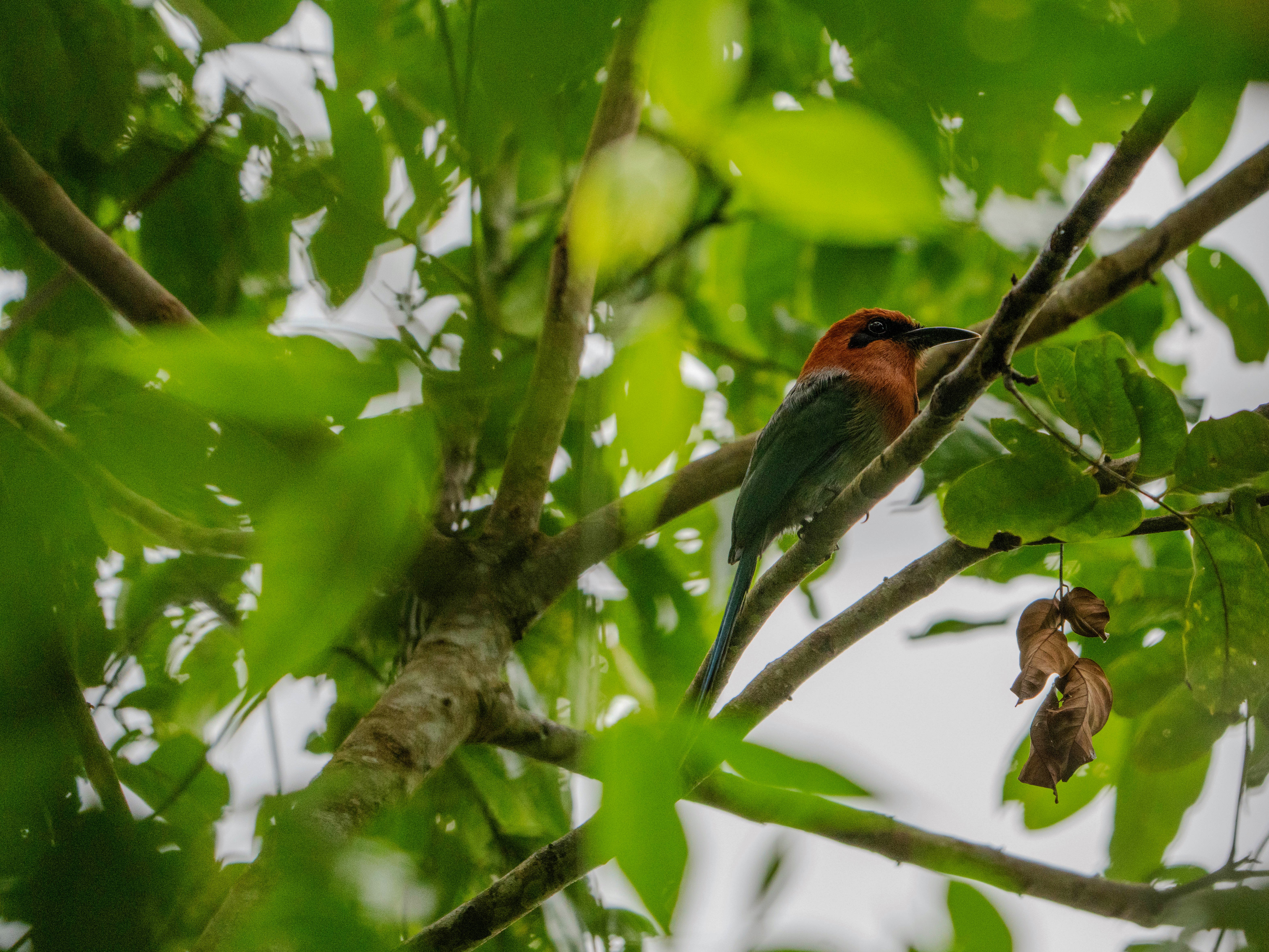
A broad-billed motmot
We were assigned a guide for the duration of our stay and had morning and afternoon activities to choose from. They provided gum boots for our walks through the muddy rainforest and Dylan and I packed our Yeti waterproof bag for the day with water, deet, rain jackets, hats, mosquito head nets and head torches. We always had my camera with the 200-600 zoom lens too. Despite the added burden of lugging the camera in the heat and humidity, it was indispensable for capturing the images we have.
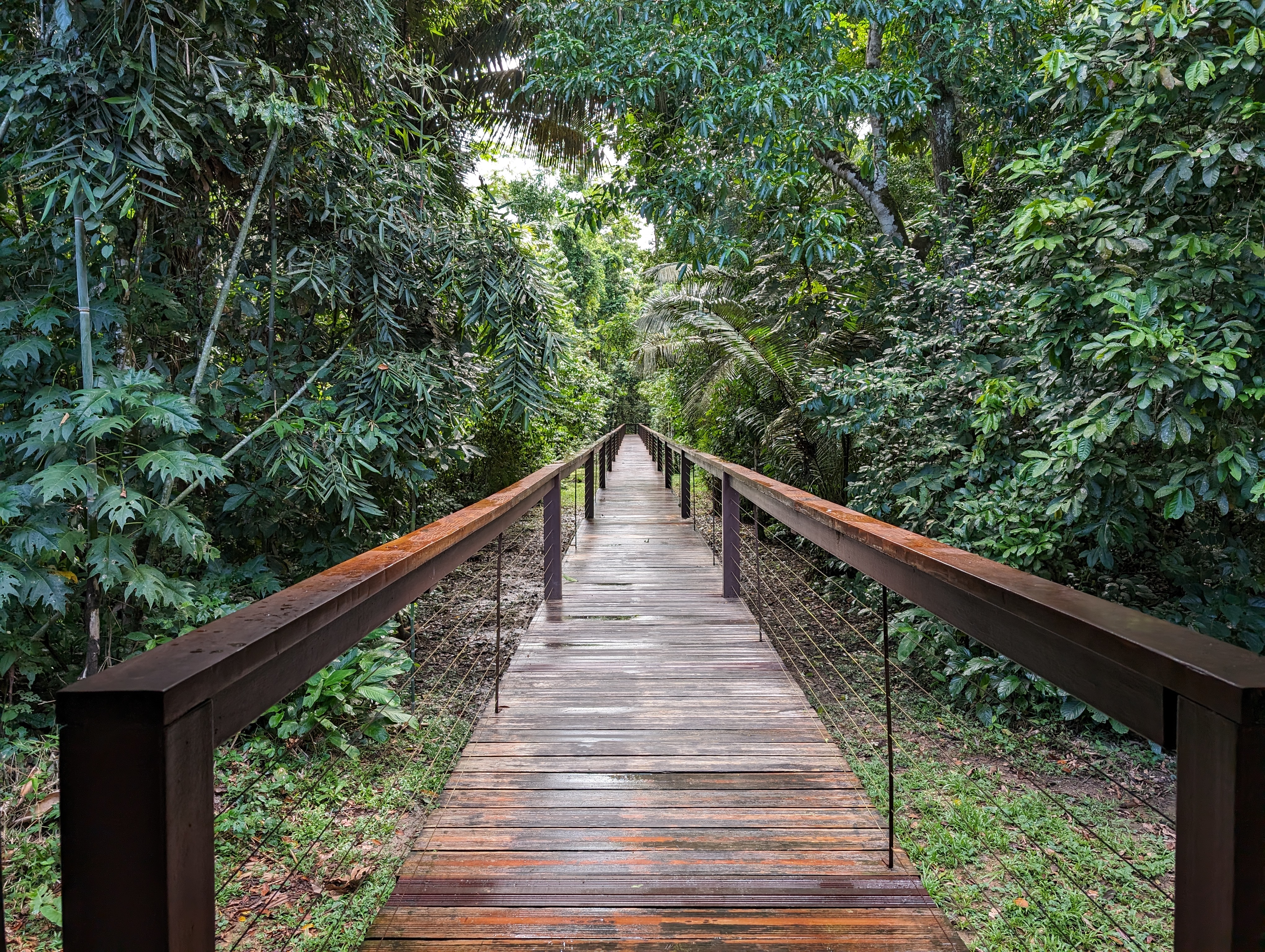
The TRC has 300m of elevated walkways situated between the jungle floor and canopy to connect the different parts of the lodge
On the first morning, we rose in the dark at 4am and took an hour boat ride downstream to a location on the Tambopata river where there is a macaw claylick; a unique experience found only in this specific area of the Amazon. Due to nutrients, most likely salt, found in the cliff soil of the river bank, the Clay Lick attracts dozens of species of birds that flock here to consume the nutrient-rich clay. There are parakeets and parrots, but it is the Amazon’s most charismatic and beautiful bird - the macaw - that leaves an impression.
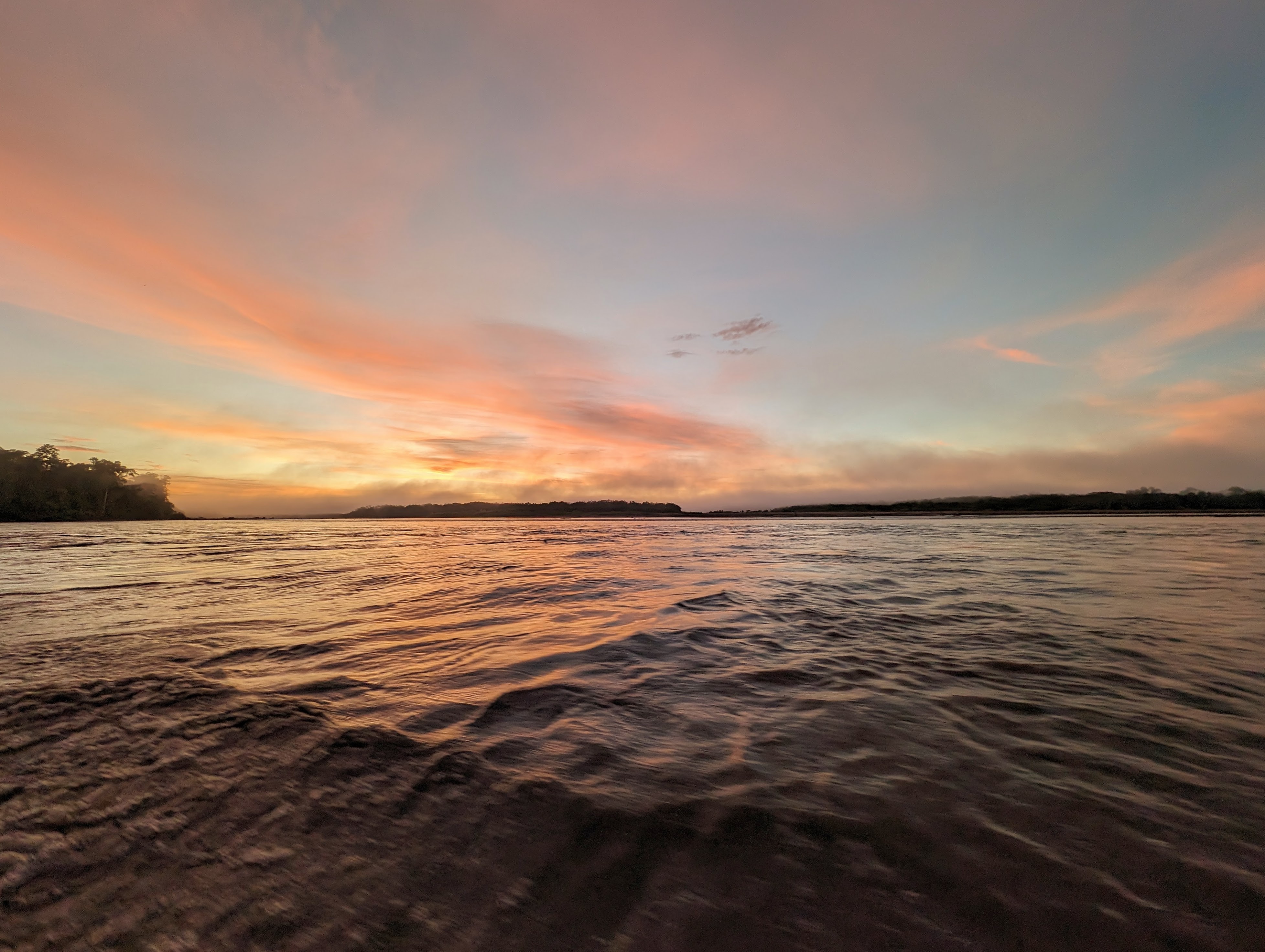
The sunrise on the boat ride to the Clay Lick
We sat on the opposite river bank in the early hours of the morning, waiting for the fog to clear and the sun to rise. After a couple of hours, the mist dissipated, and we started to hear the first of the macaw’s distinctive screech, signalling their approach.
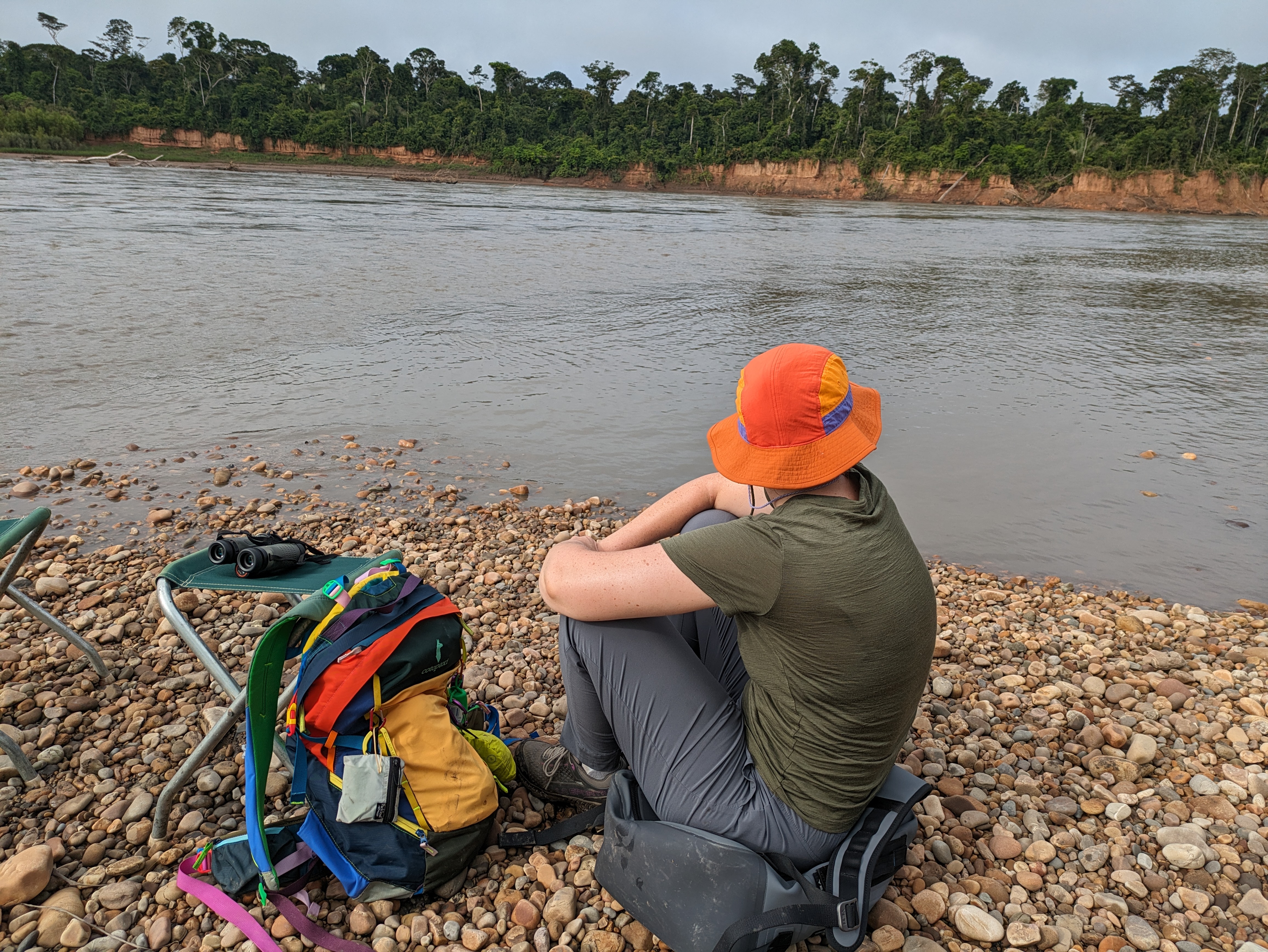
Waiting for the birds to arrive at the Clay Lick
The birds all gather in the trees above the cliff, and then start swooping down to feed off the clay, a variety of different species all mingling together, their bright colours creating a dazzling wildlife display. There were at least 50 macaws along the Clay Lick and in the trees above; a distinctive wildlife spectacle not to be missed.
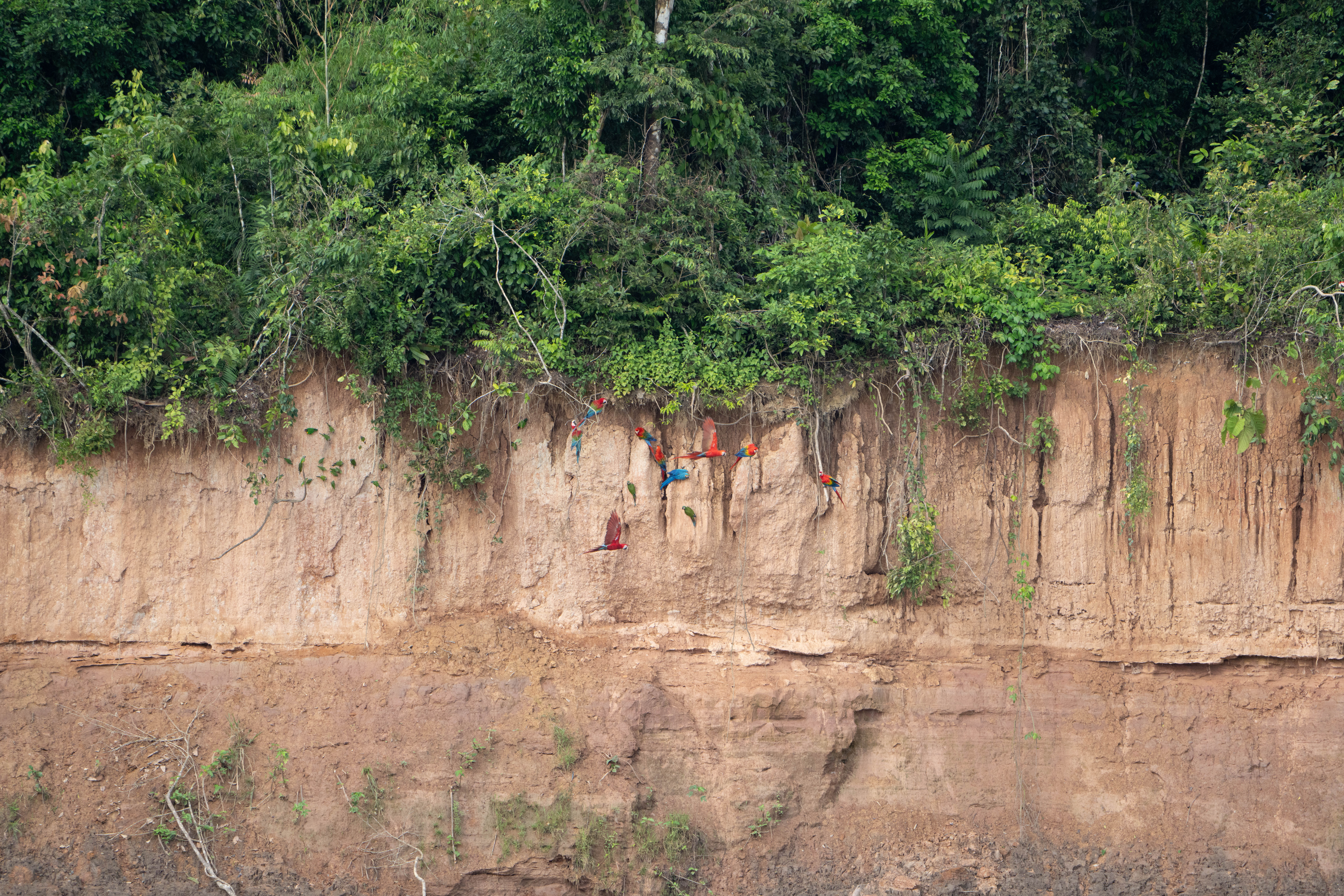
The birds gathering at the Clay Lick
On the way back to the lodge, some of us dozed on the boat, struggling to stay awake after our second 4am start to the day.
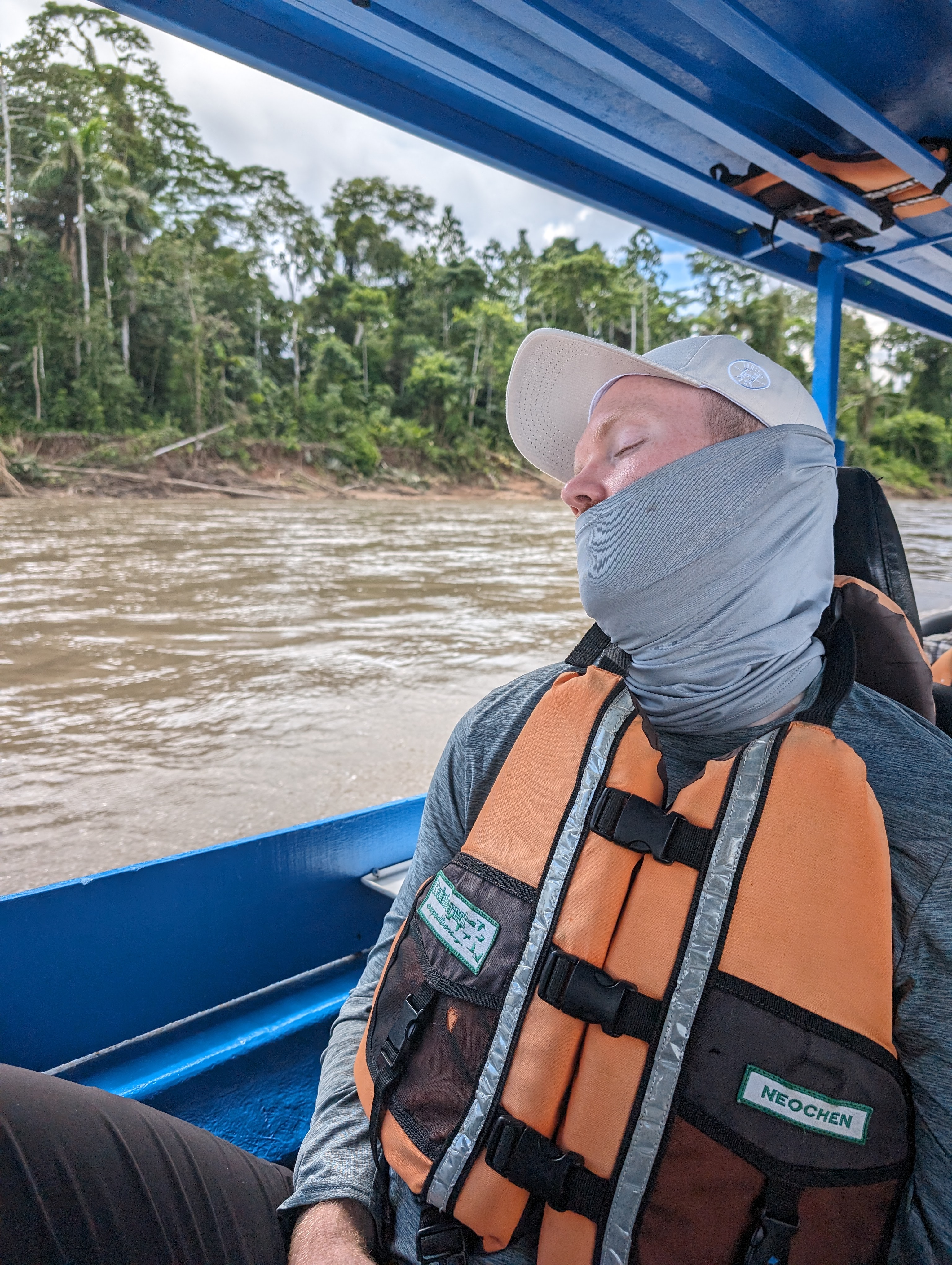
But we’d become alert when a photo opportunity arose as someone spotted something.
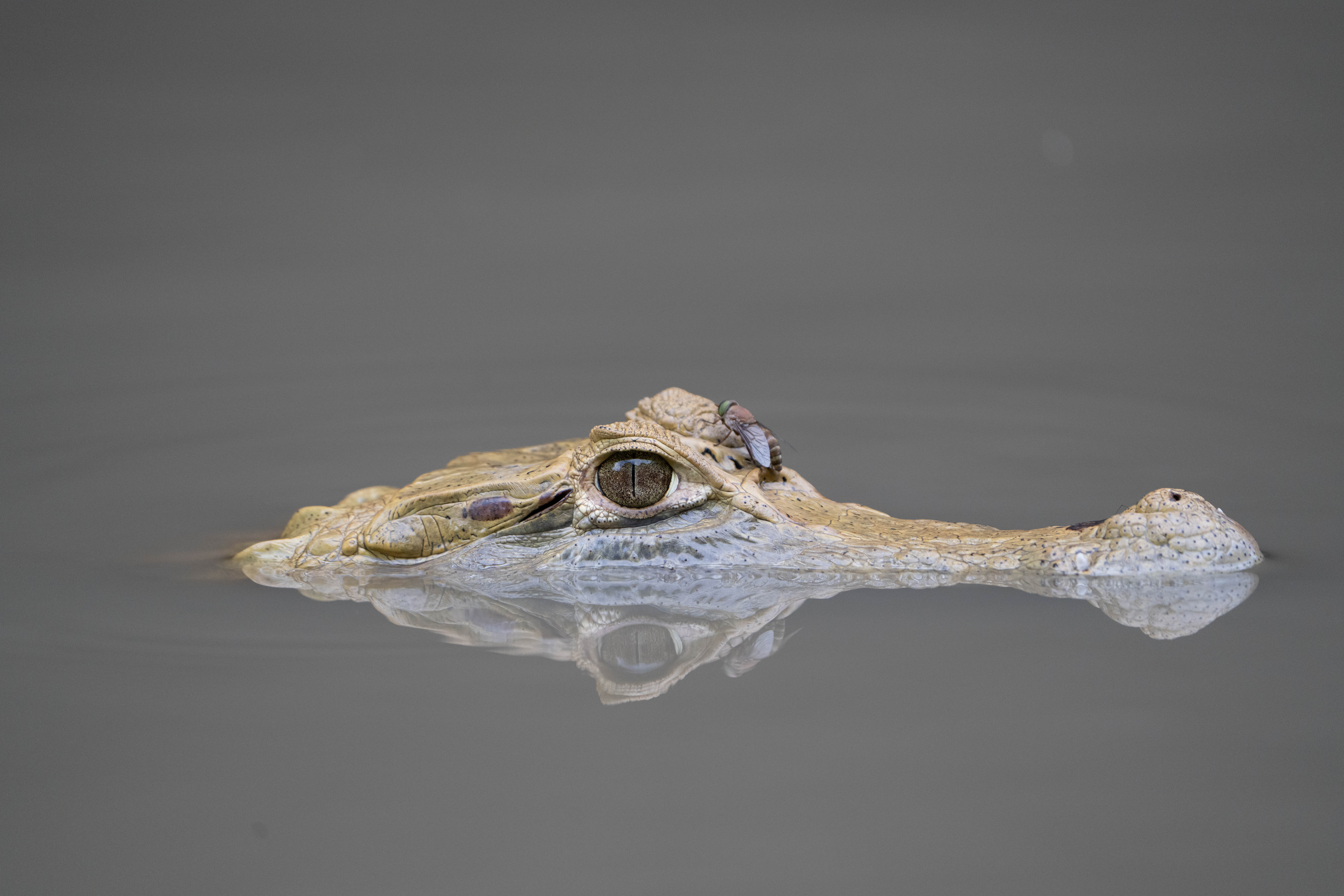
A small cayman in the water
After a cold shower, lunch, a nap and another cold shower, we set out for our afternoon activity. We were guided on a walk through the rainforest to a recently built canopy tower; a 35m high metal structure that brings you up into the canopy of the rainforest.
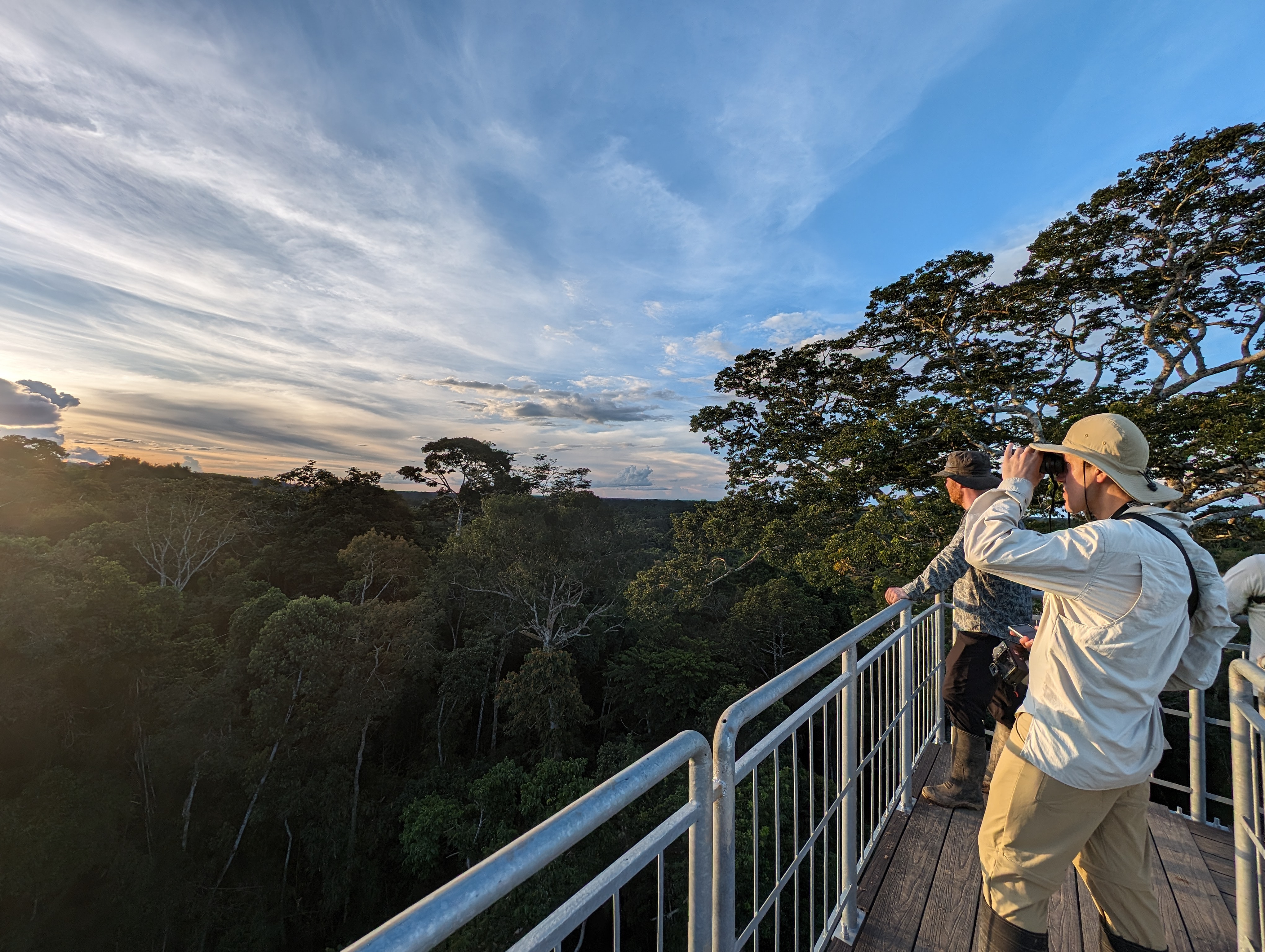
Dylan looking out from the tower
We reached the top of the tower, drenched in sweat. Now, out of the shade of the jungle and in the direct sunlight, we stood and waited, the air still and thick. As the sun started to sink below the tallest trees, the jungle started to stir. Flocks of hundreds of oropendolas flew overhead, macaws landed in the canopy of trees next to us, and the rustle of leaves below revealed the first monkeys playing in the branches.
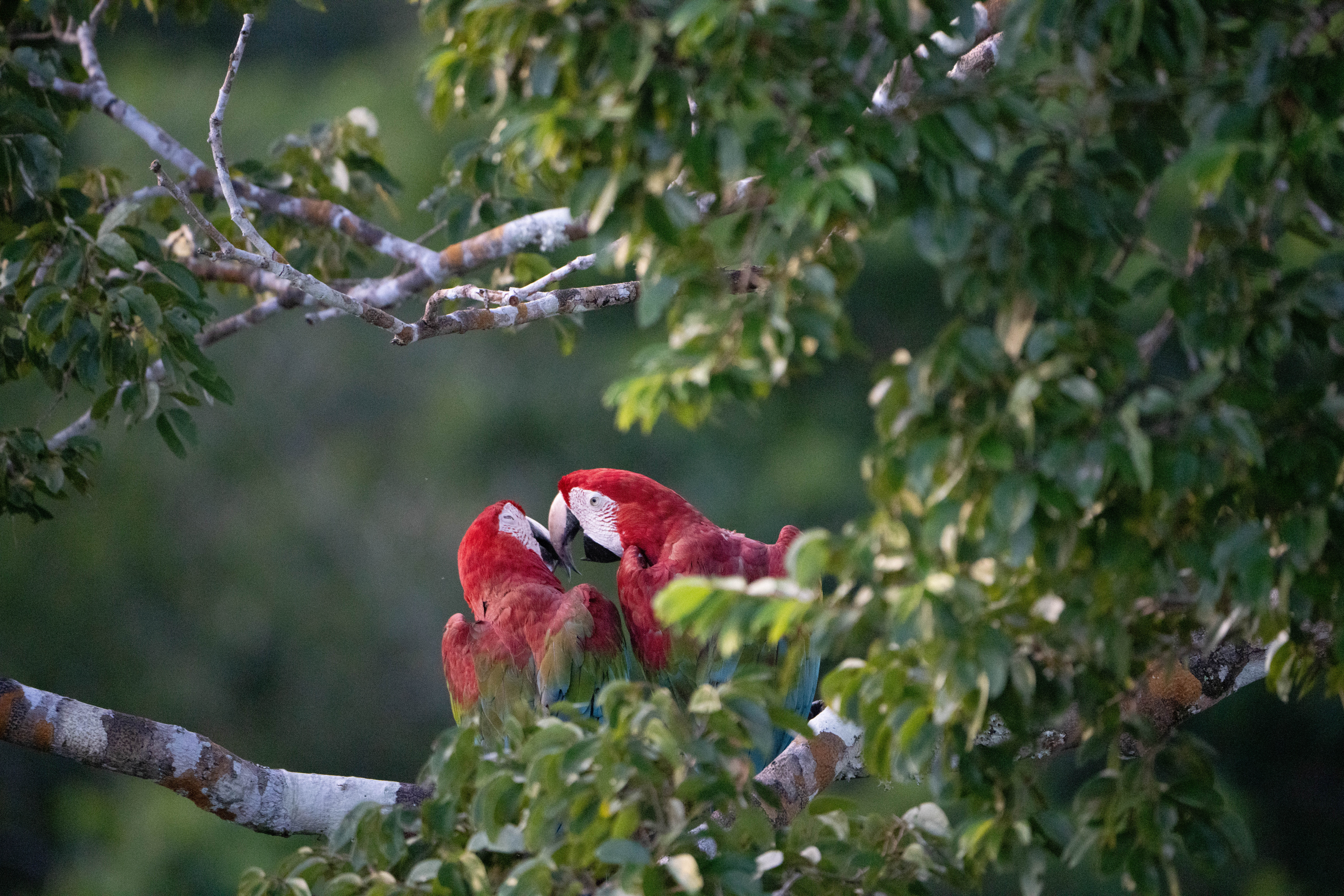
A pair of macaws sitting in the canopy next to us
From up here, we had a new perspective of the rainforest, seeing its creatures at eye level and from above, rather than the neck-straining gaze upwards that we’d become accustomed to.
Our walk back to the lodge was guided by our head torches as the sun set and the dark forest enveloped us. At night, the jungle comes alive with different creatures; frogs and spiders. That night, we came across a giant tarantula. I was relieved we’d seen it out on the trail, until later I learnt from another guest she had one just outside the door to her room. That was one creepy crawly I was not going to get used to.
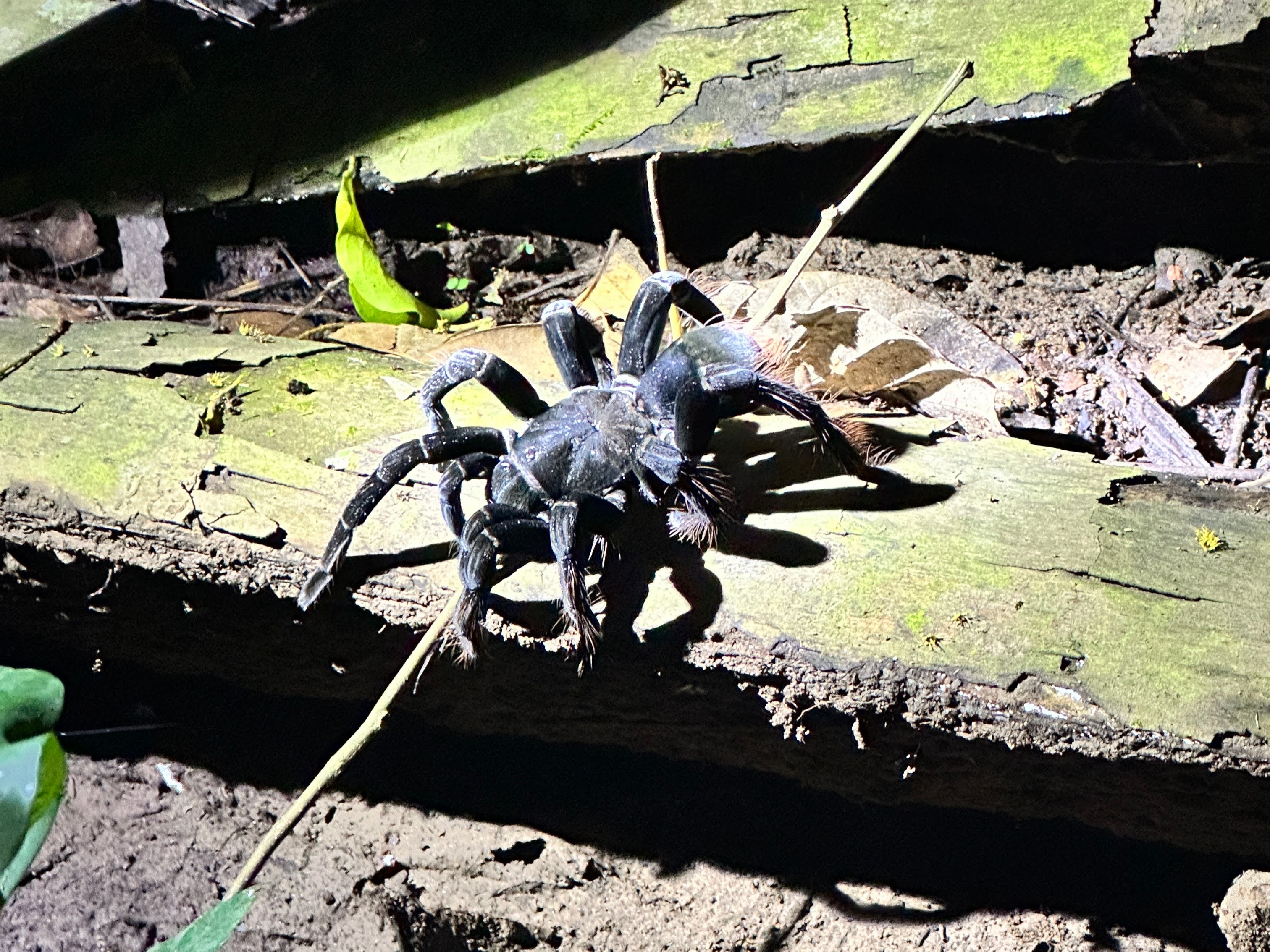
The tarantula we found on our night walk back from the canopy tower, photo by Max
Our room, being open to the forest, was constantly filled with all manner of bugs. There were giant moths larger than my hand and bright green grasshoppers, one of which I crunched underfoot as I walked out of the bathroom. I was glad I was wearing my thongs and decided at that moment, I would not be without them on my feet other than when I was in bed. Like when I was forced to overcome my fear of sleeping outside of a tent while hiking, I was forced to accept my cohabitation with insects, and in the end, they bothered me far less than I imagined they would.
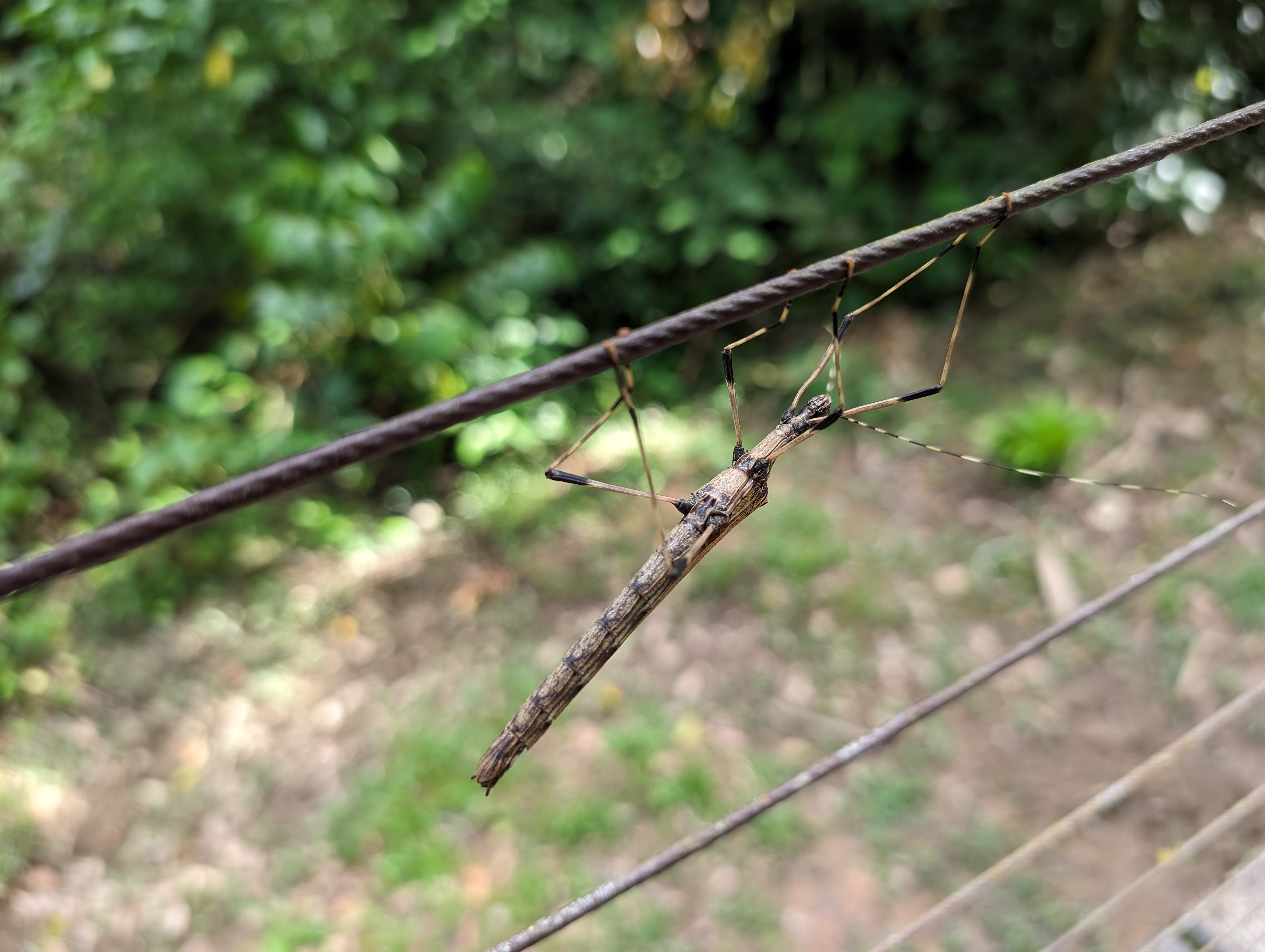
A stick insect on the walkway
Other than the bugs, our fear before arriving was that we’d be unable to sleep at night. After the experience in Lima, we were worried that the heat and noise would make sleep elusive. As it turned out, while the conditions weren’t ideal for great sleep, we managed to sleep well enough. We were so tired from the early starts and it cooled down just enough at night that eventually we’d drift off. The animals were relatively quiet at night and the mosquito net prevented any buzzing creatures from getting too close.
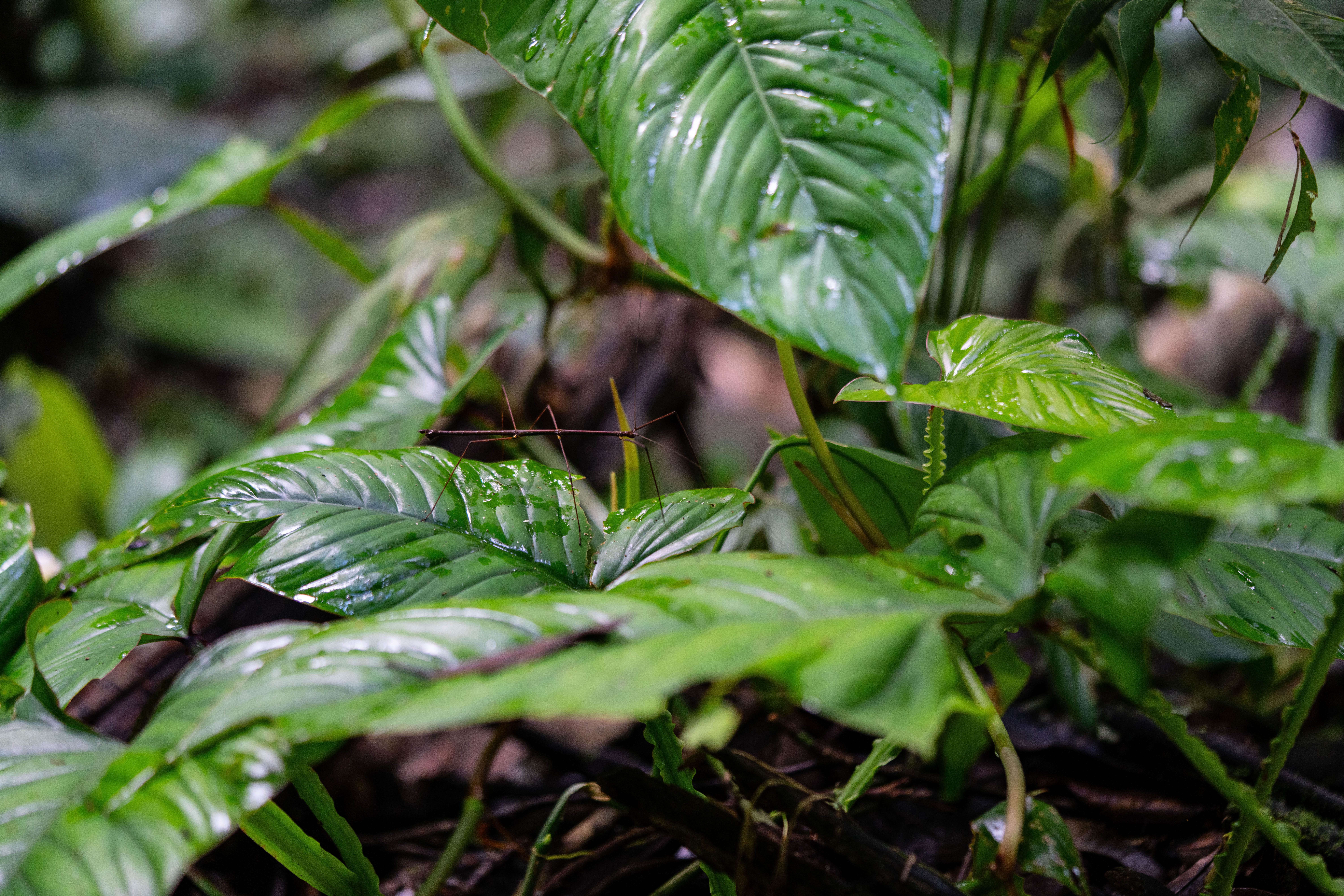
A stick insect on the forest trail
As it turned out, the greatest disruptor of enjoyment was the humidity. It was relentless. With open air lodges and no air-conditioning, there was no respite from the steamy air for five straight days, and I was not coping well. We came back from our activities wet with sweat and took cold showers 5 or 6 times per day, but we had limited clothes and so the same ones would go back on again after a shower. We were now over a week without access to a washing machine and so we hand washed some clothes, but even our quick-dry hiking gear wouldn’t ever fully dry in the high humidity. It was certainly a change from our luxury river cruise a few days earlier where we were enjoying an air conditioned boat and clean, dry outfits to change into after each excursion.
On the third day, I decided to skip the activities and stay in the lodge to catch up on writing this blog and sorting through photos. On the previous afternoon, when we went to the canopy tower, the walk back had been torture. The beads of sweat clung to my face and my clothes stuck to my skin. It was so hot and humid and I couldn’t cool down and the sweat wouldn’t evaporate. It wasn’t helped by the fact that we needed to wear long sleeve shirts, trousers and knee-high gumboots to prevent mosquito bites, and the hat and head net prevented any heat loss through the head. I was close to passing out or vomiting (or both), and decided I couldn’t do that again. My decision was made easier when it was raining the next morning.
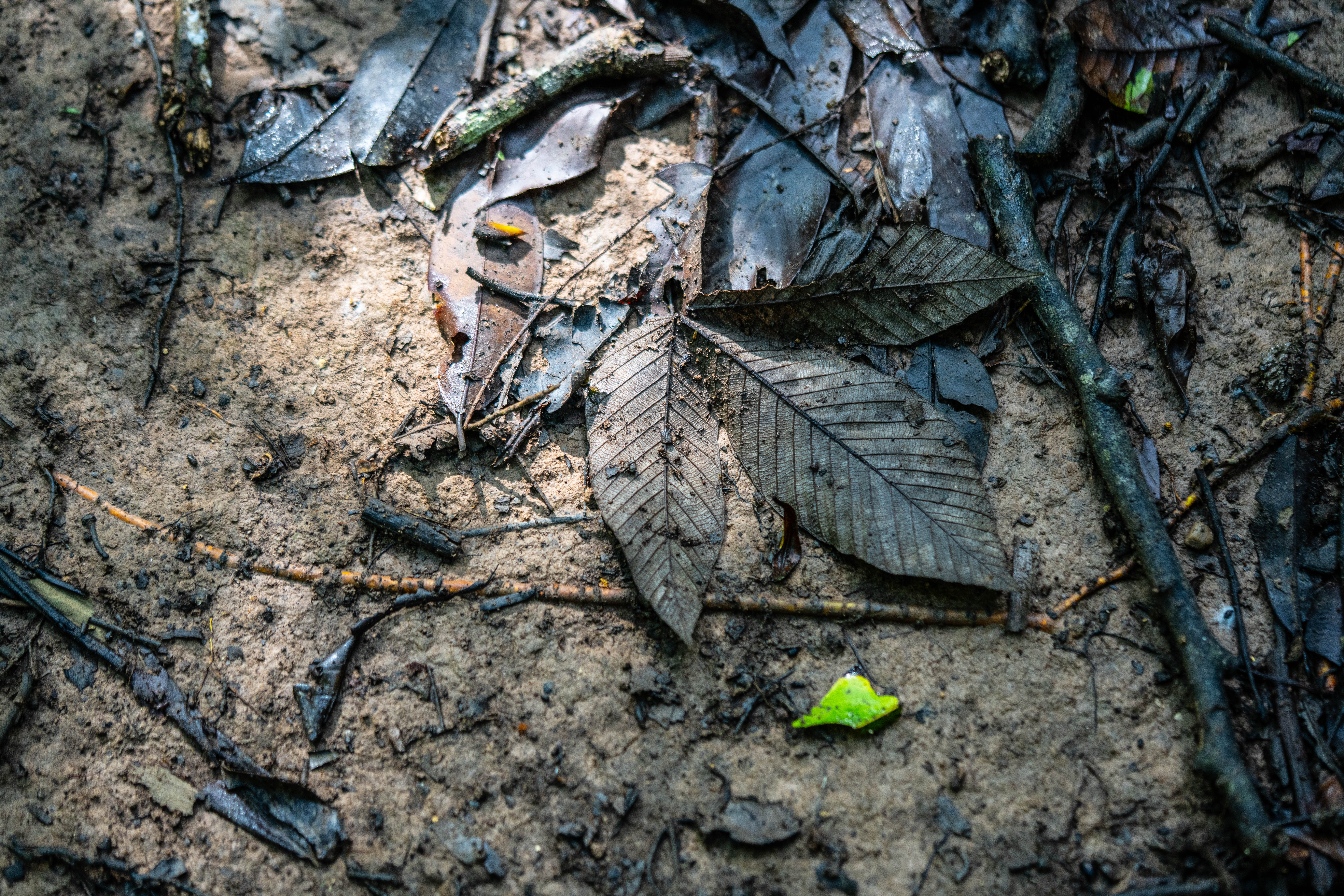
Instead, I enjoyed a sweat-free and mostly bug-free morning writing from the safe haven inside my netted bed while listening to the rain falling against the forest floor and the birds singing songs from their hidden places among the trees.
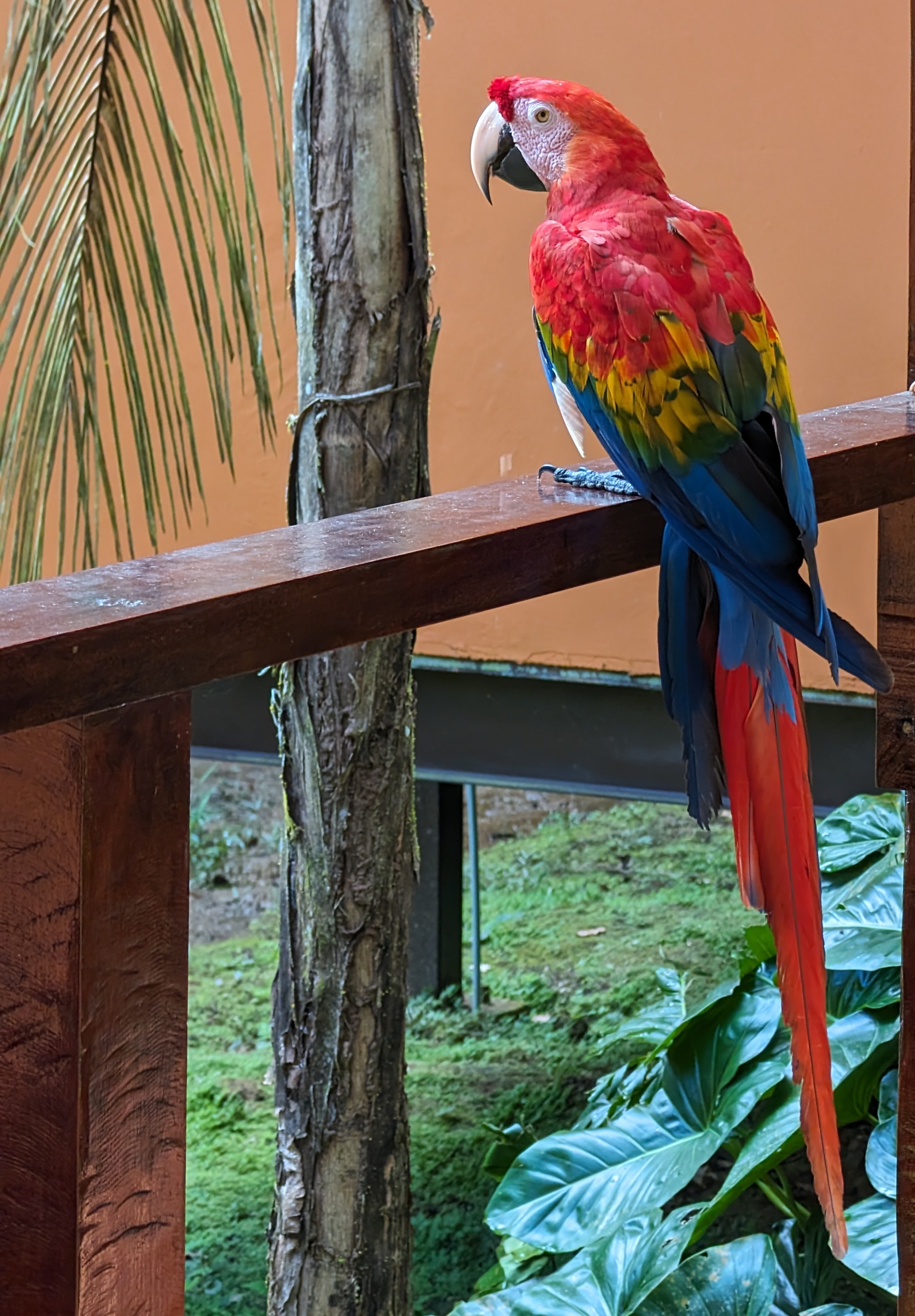
A scarlet macaw visiting the lodge
That afternoon I rallied and joined the sunset river cruise. It was much more pleasant being on a boat, the movement generating a cooling breeze and keeping the bugs away. We navigated down some smaller tributraries and came across a large cayman. We also found another capybara and more macaws as we enjoyed the beautiful sunset casting a pink glow across the sky.
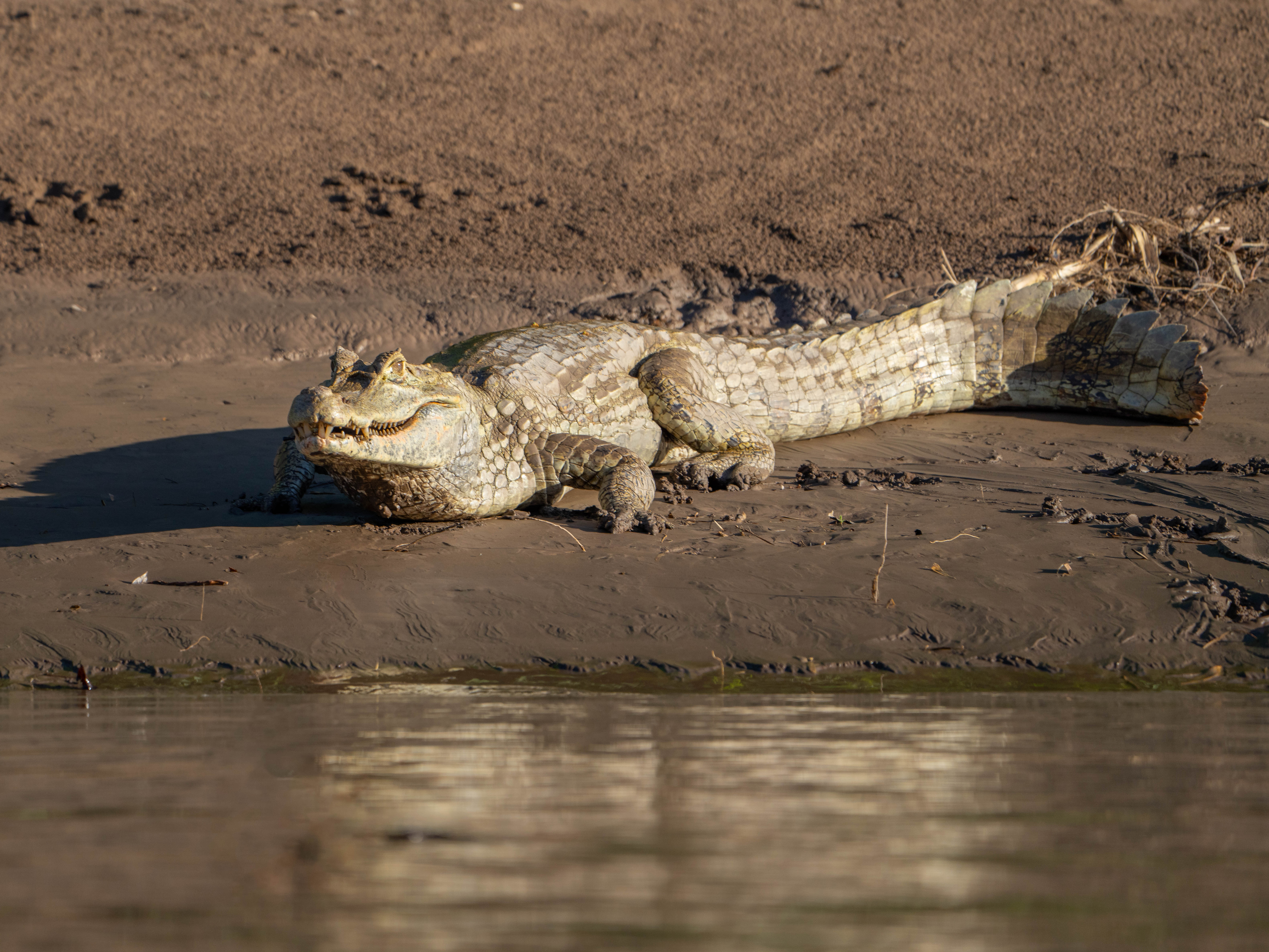
A cayman on the river bank
The next day, our final day of activities before departure, we spent the morning walking a different trail around the lodge. I took my macro lens so I could take photos of fungi on the forest floor.

Fungi on the forest floor
While we waited for our afternoon forest walk, we were treated to a visit from some monkeys who were playing in the trees just next to the main lodge. For our afternoon activity, we took a short boat ride to a small island in the river for another forest walk, but we didn’t see much other than some more macaws, so in the end we saw more animals at the lodge that day than further out in the forest. The guide said there was a jaguar that sometimes came to that island (they can swim), but I was in two minds about whether I actually wanted to come across a jaguar while on foot.

Monkeys in the trees near the lodge
That evening before dinner we decided to sit at the bar for a few cocktails since we didn’t have to get up early for any activities the next day. We’d already had a few good cocktails in the past few days and so were surprised at how good the drinks were given our location. It was hard for the bartender to get many rums and other ingredients and so he had started making his own spirirts like falernum and orange curaçao. He gave us tastings and they were good. We got chatting and as it turns out, he previously worked as a bartender in the US, and loved tiki cocktails. His real job at the TRC was bookkeeping, and the cocktails were just something he did for fun. We chatted about tiki drinks and our favourite tiki bars around the world and inevitably the subject got on to the mai tai: the quintessential tiki drink by which tiki bars are judged. It wasn’t on the menu since he didn’t keep orgeat (an almond syrup used in the mai tai), but while we were at dinner, he whipped up an orgeat using brazil nuts (because there are no almonds in the Amazon) and then served us an excellent mai tai.
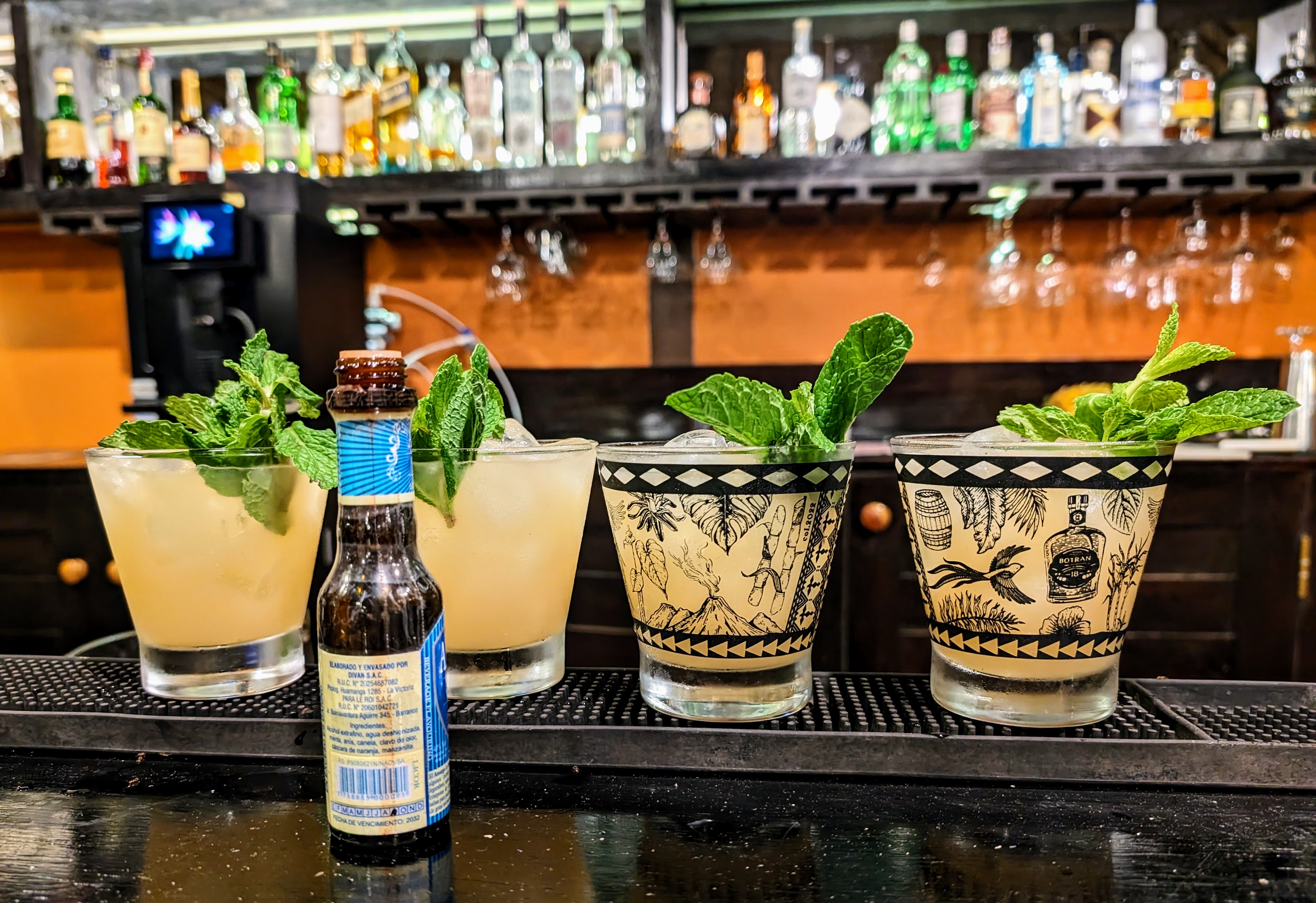
Mai tais at the Tambopata Research Centre bar, made by Louis
Over the years we’ve experienced a number of unique interactions with bartenders that have led to some very memorable cocktail bar experiences. It can never be planned or expected, and so when one of these encounters does happen, it is a special moment that creates a lasting memory. This was one of those moments. It was not the best bar, nor the fanciest, or the most interesting, and it certainly wasn’t well stocked, but it was the most surprising, and for that reason, all the more enjoyable. We never expected to encounter a well-trained bartender making great cocktails comprised of his own tinctures and syrups in the most remote jungle lodge in the world. It was true serendipity.
On our final morning at the TRC, we had a sleep in until 6am and then after a leisurely morning packing up, commenced the journey back to Puerto Monaldo in reverse: first, the walk through the forest, then the boat ride, the long drive along the bumpy dirt road, the bag re-pack, and the drive to the airport. We arrived at the airport around 3.30pm and hadn’t eaten since breakfast at 6.30am. We weren’t expecting much by way of food at the tiny, single gate terminal that is Puerto Monaldo airport, and so were delighted when we found a small restaurant making pizza. Not just pizza, but hand-made dough cooked in a wood-fired oven. Sometimes there are these tiny miracles that occur when you are travelling that make all of the hard stuff worthwhile. Happy and no longer hungry, we took our flight back to Lima and after another night at the Lima airport hotel, we three weary travellers parted ways: Dylan taking a flight to LAX to return to Sydney via the US, and me and Max taking a flight to Santiago to return to Sydney via Chile (having finally received our visas with relief).
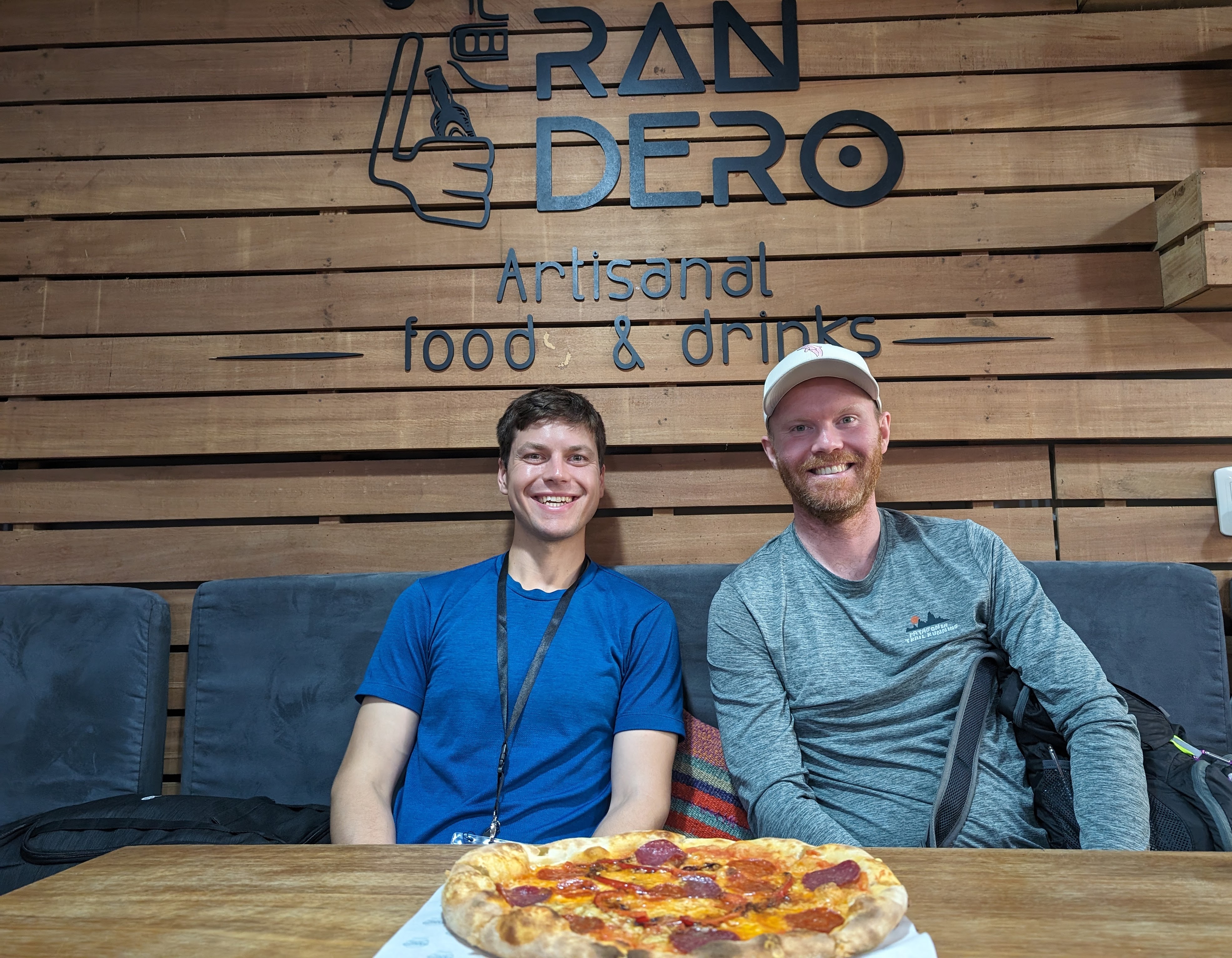
Pizza at Puerto Monaldo airport
There are only flights every second day to Sydney from Santigo and so before our 15 hour flight home, Max and I spent two nights at the Ritz-Carlton in Santiago. We weren’t sure what to expect because it wasn’t that expensive, but it exceeded our expectations in every way. The hotel was so beautiful and the service was impeccable. After checking in, we met at the bar and had pisco sours and burgers for dinner. After a great night’s sleep and excellent breakfast, I took a leisurely walk outside around the hotel and then spent the afternoon at the hotel pool. The day was only improved with a massage at the hotel spa and news that we got business class upgrades for our 15 hour flight home.
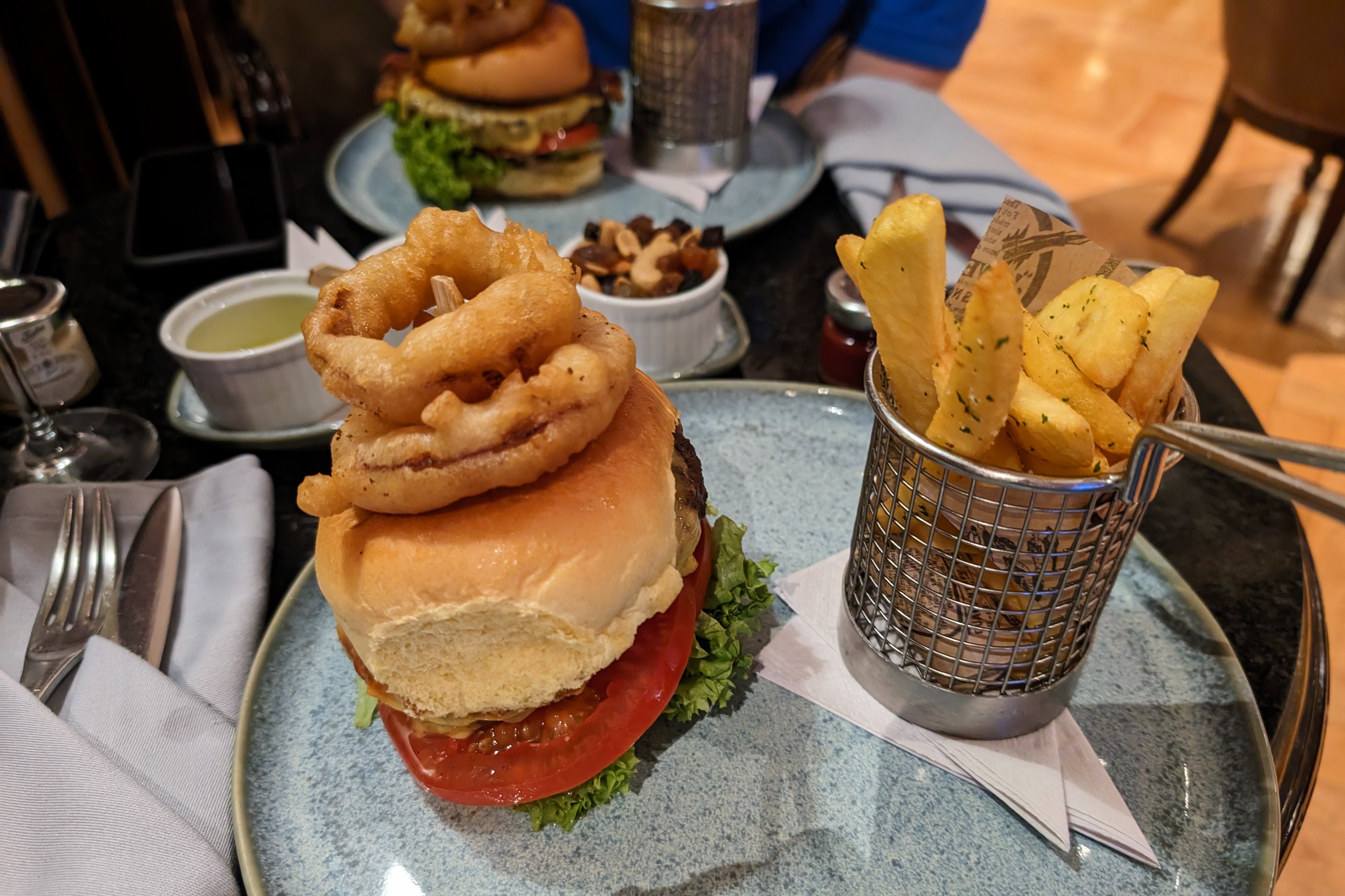
Burgers at the Ritz-Carlton
Max and I enjoyed our last dinner at the hotel, with more pisco sours and a bottle of Carménère Chilean wine. Carménère is one of the most ancient European grape varieties and is considered one of the original six red grapes of Bordeaux. However, it is now rarely found in France or Europe as the variety was mostly destroyed in the phylloxera plague in 1867, which nearly destroyed all the vineyards of Europe. But some of the vines had made it to Chile before then and so it now thrives in Chile; the world’s largest producer of this variety.

Dinner in the wine cellar in the Ritz-Carlton dining room
Our journey to the Peruvian Amazon really was a once-in-a-lifetime adventure. It was extraordinary, but it was also challenging at times. It was uncomfortable. And it was tiring. Type 2 fun. If you weren’t awake at 4am for your own early morning birding activity or woken by other people getting up for theirs, then you were certainly awake by 5am when the howler monkeys started howling or the macaws started screeching. It was truly an immersive jungle experience that we’re unlikely to ever experience again. And that was entirely the point.
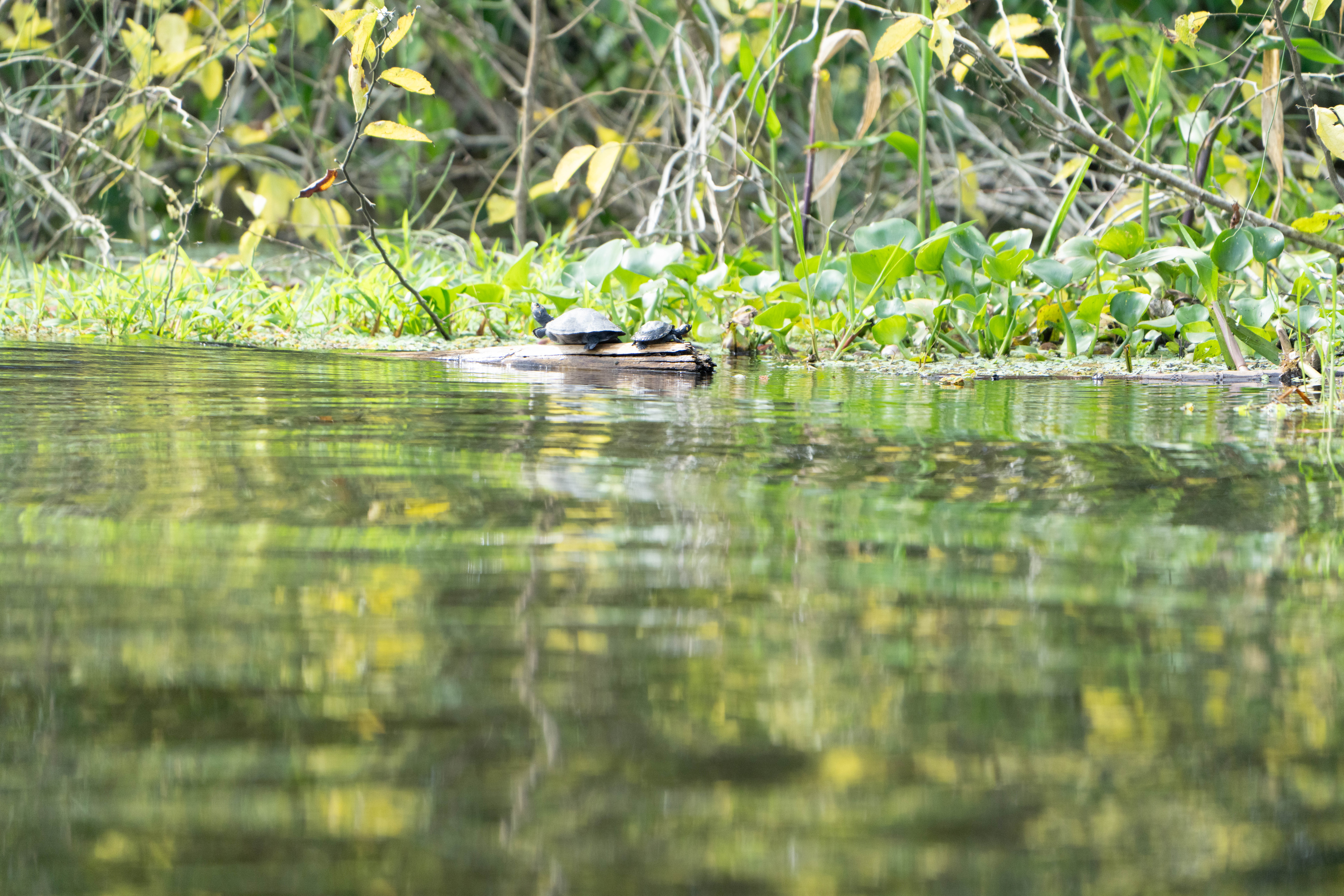
Turtles on a log
When visiting a protected area like this that is so remote and retains such high biodiversity you can begin to imagine what a wild place our entire planet once was. But even this place is changing. People who visited years ago remark at how there are less animal sightings now than there used to be. The buffer zone of these protected areas is becoming increasingly fragile.
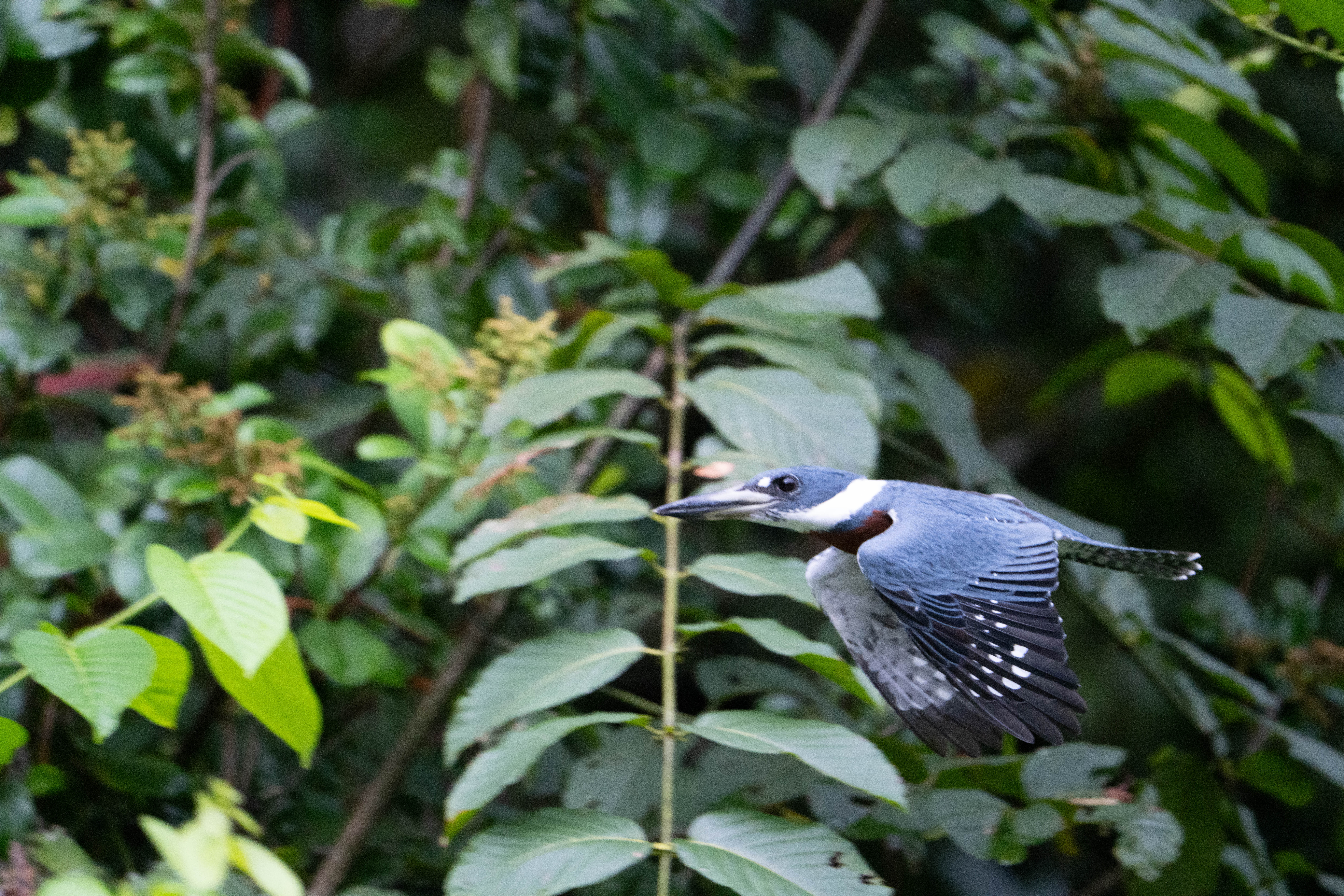
But that seems incredible to us given the proximity we were to so many creatures. The lodge is connected by 300m of elevated boardwalk. Just walking from our room to the dining room, I saw monkeys in the trees above. We were so fortunate to have this experience, and are so grateful for being immersed in one of the last truly wild places on Earth.
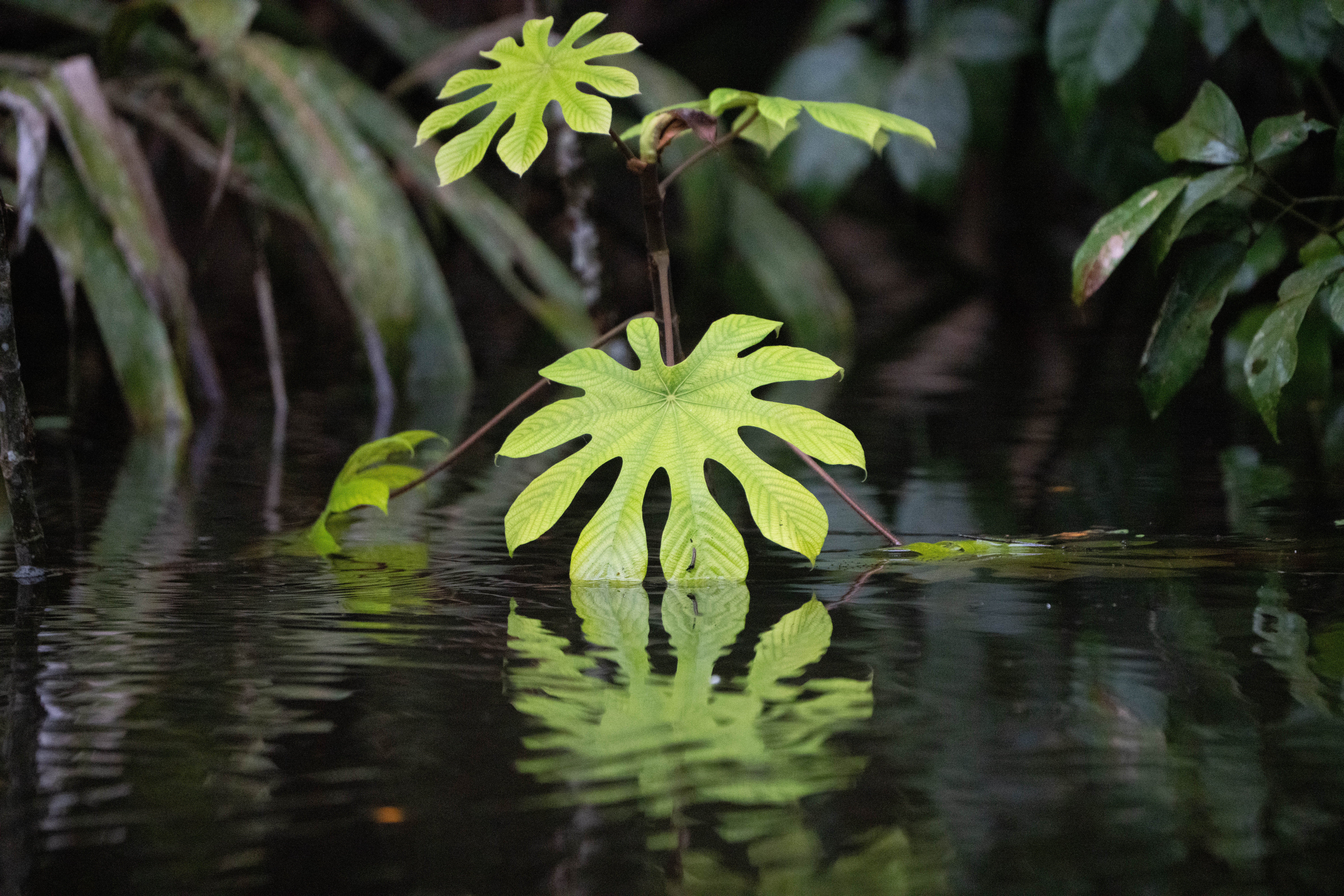
But it’s always nice to come home. Travelling broadens the mind and replenishes the soul, and makes us all the more grateful for the everyday pleasures and comforts we have at home.
